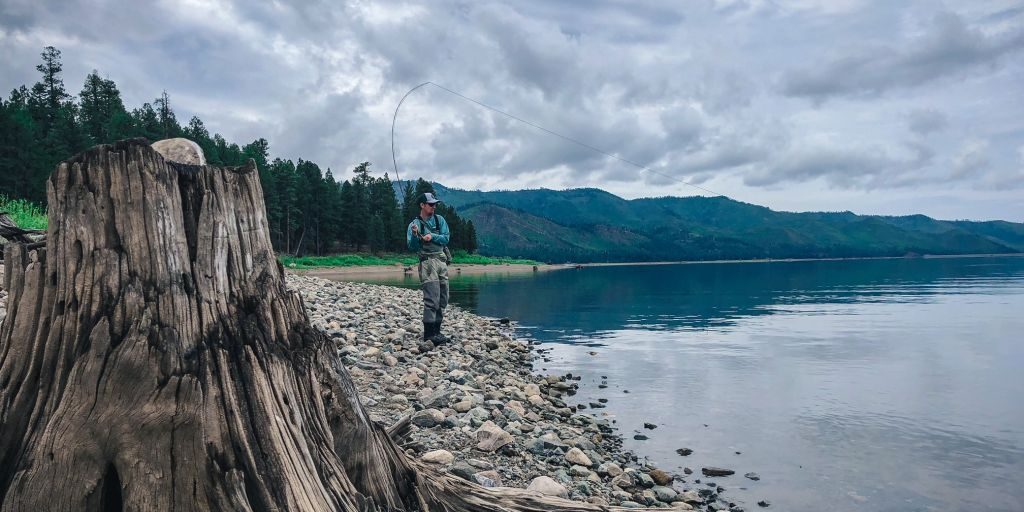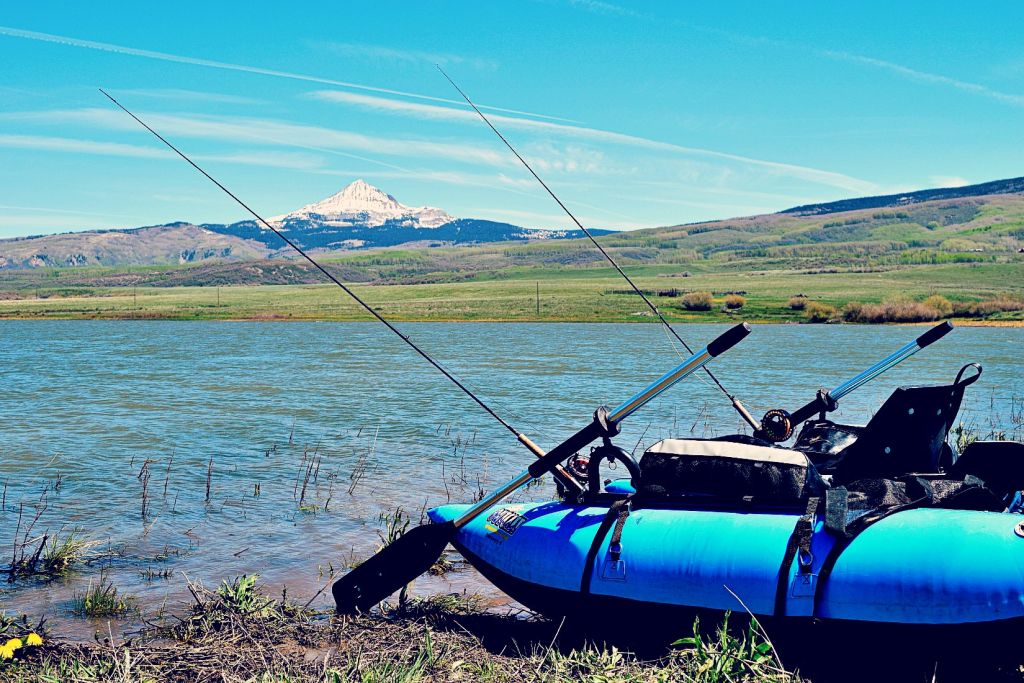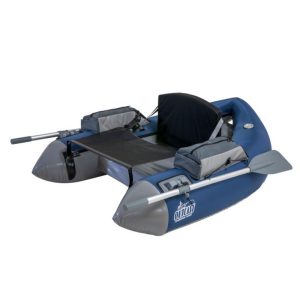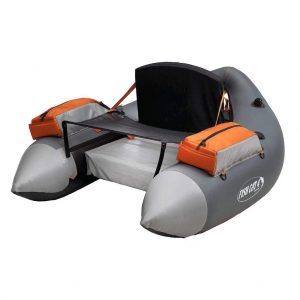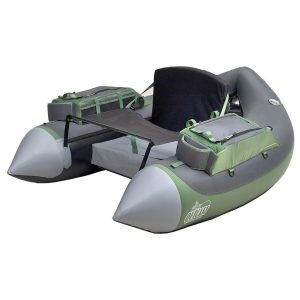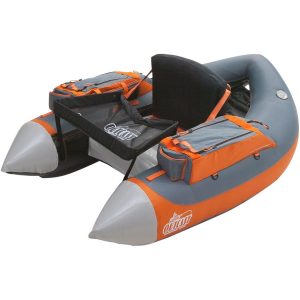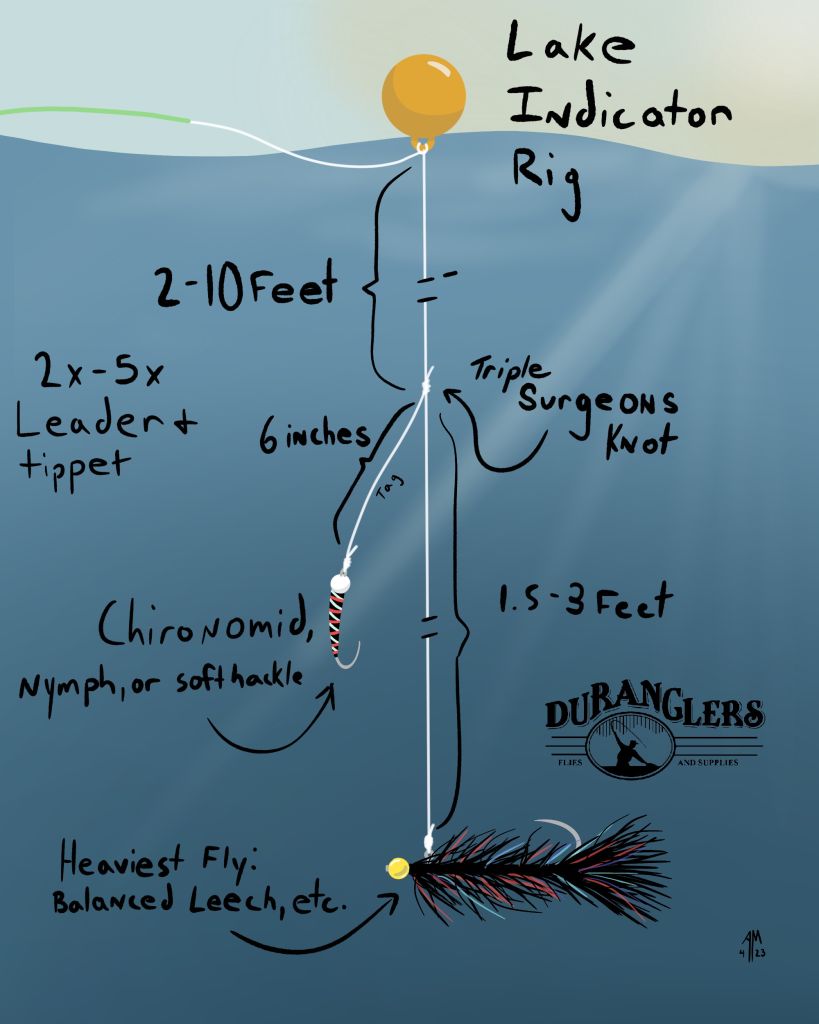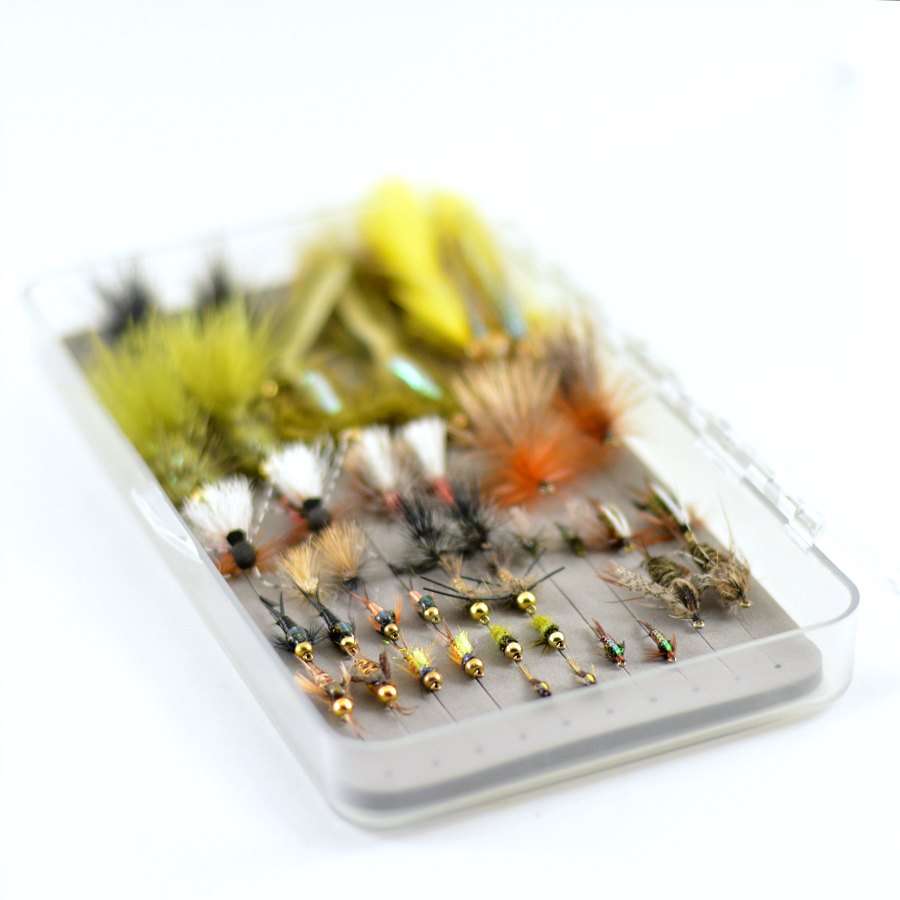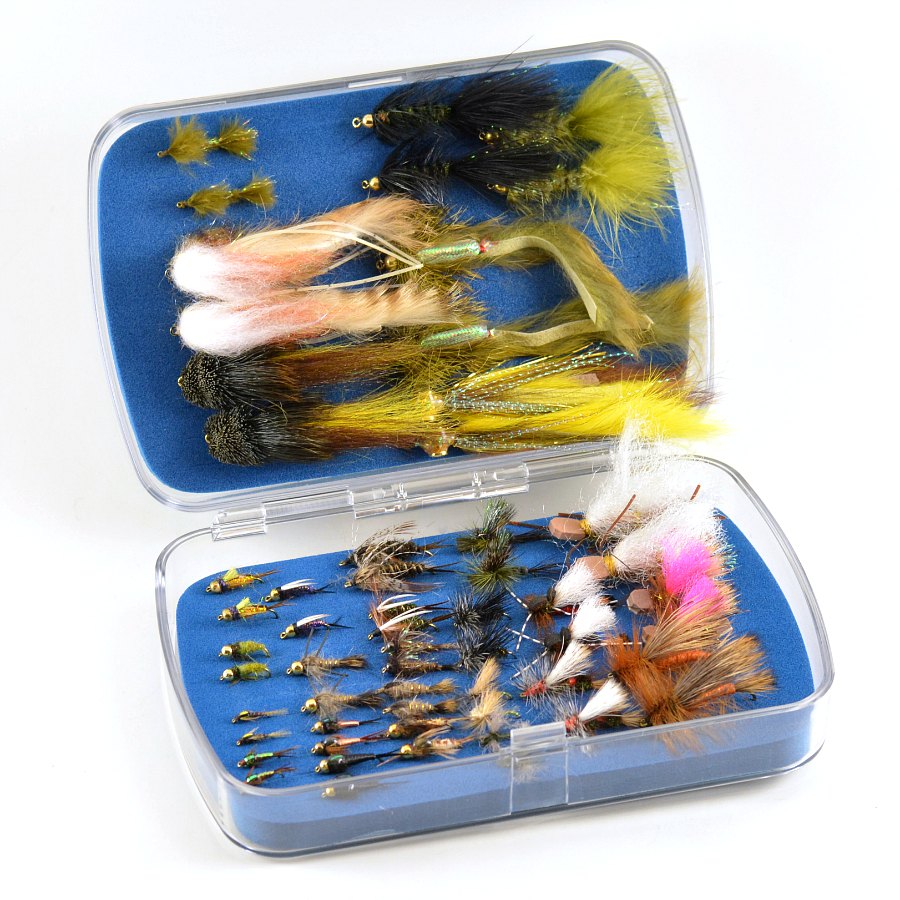Beginner’s Guide to Fly Fishing Lakes for Trout
The why, where, when, what, and how of fly fishing in lakes for trout.
At the onset of the first warm days of spring comes snowmelt in Colorado. Snowmelt means cold and dirty rivers and creeks, and dirty rivers result in the inevitable fly shop question we so often hear at Duranglers:
“Where can I fish that isn’t blown out?”
Our usual reply to this question is something along the lines of “taliwaters” such as the San Juan River (which is experiencing its own dirty water snowmelt event this spring), or “lakes and reservoirs”. At 40 years in business, we can almost predict the unfortunate follow-up response will be when we answer “lakes”:
“I don’t fish lakes.”
or “I prefer to fish moving water.”
or “I don’t know how to fish lakes.”
This is an unfortunate response because it seems many folks would make the choice to either not fish, or fish a dirty, high, and cold river where chances of catching are low, as opposed to fish a lake where fishing is typically on FIRE in the spring and early summer. The “barrier for entry” on lakes is pretty low too, just a few flies and your trusty 9 foot 5 weight will do to start. While specialty equipment can certainly help (and we will talk more about that below), you probably have most of the gear you are going to need to catch trout in your pack or vest already.
Lakes seem big and weird and can feel pretty overwhelming when you get out and actually look at them from an angler’s point of view. What I hope to make clear through this long-winded blog post is this: not only CAN you fish a lake, but you can do it pretty successfully RIGHT NOW with the gear you have on hand!
If you still are unsure about fly fishing a lake and feel they are best reserved for the spin fisherman or you are a “moving water purist”, this guide is for you. Sit back, grab a favorite beverage, and take a deep dive in with us in our Beginner’s Guide to Fly Fishing Lakes for Trout where we are going to talk about the why, where, when, what, and of course, the how of fly fishing in lakes for trout. Or…you could cut that learning curve down quite a bit and book a guided lake fly fishing trip with us too.
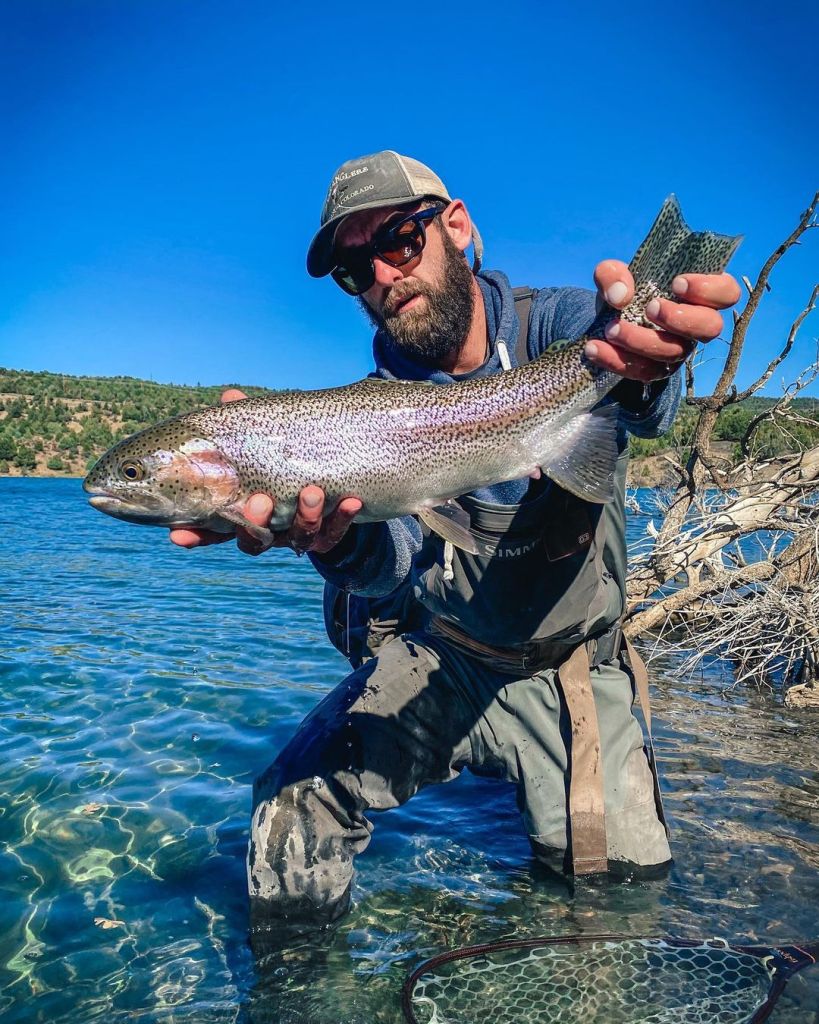
Using Duranglers 5 step program, you too can catch piles of trout when our local rivers are high and muddy.
Table of Contents
This post got long-winded. Use this to quickly navigate to what you want to learn.
- Why fly fish lakes for trout?
- Where to fly fish lakes for trout?
- Colorado Lakes
- Local Durango Lakes
- Where to actually fish on a lake!
- When to fly fish lakes for trout?
- Spring
- Summer
- Fall
- Winter
- What to fly fish lakes for trout with?
- Watercraft
- Fly Rods
- Fly Reels
- Fly Lines
- Leaders & Tippet
- Flies
- How to fly fish lakes for trout?
(After your read-up on fly fishing lakes, watch this incredibly informative video from our friend Simon Gawesworth over at Far Bank that will teach you many of the subtle nuances about fly fishing lakes!?
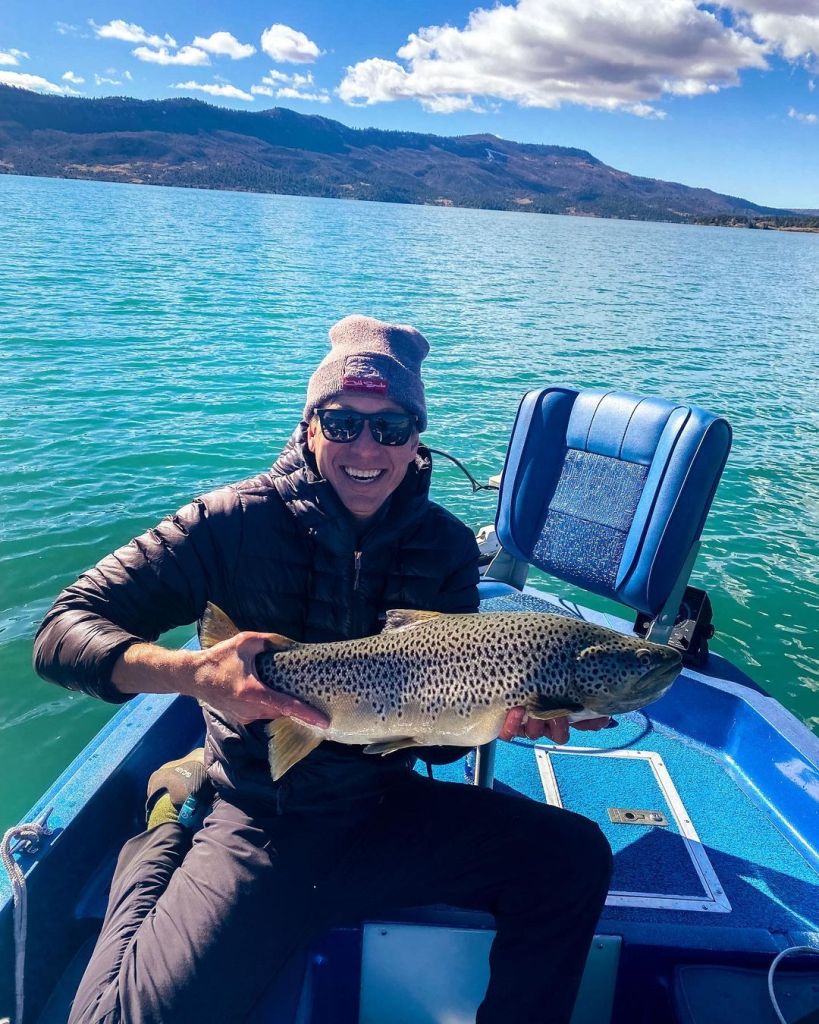
If brown trout like this don’t rustle your jimmies, are you even alive?
Why?
I feel that the “why” of fly fishing in lakes and reservoirs has to be covered first before we move on to the more technical aspects of this style of fly fishing. With the pushback we receive from people who won’t even entertain the idea of fly fishing in a lake, the question of “why do it” comes first.
If the photo to the right does not give you a quick reason as to why, well I may not know how to help you. However, there are a few darn good reasons why…
- Because learning to fish lakes and reservoirs is a new challenge! Learning new bodies of water and how these fish behave will make you a better angler overall. Figuring out the temps and depths fish hold and structure situations will help inform how you approach your next river mission.
- Though competition is hardly a good reason to go fly fishing: lake fishing is a part of many international fly fishing competitions. If you are one of the few who want to compete, you better figure out lakes! You can’t just Euro nymph your way through life after all. (see number 1.)
- The rivers and creeks in our area and throughout the western United States are getting quite crowded with summer anglers. Lakes offer new and often overlooked water to fish.
- Depending on the lake, trout have better opportunities to grow to absolutely enormous sizes. These fish are hard fighting and as picky as the worst tailwater midge eaters at times. They will truly test your angling abilities.
- You can pretty much fish lakes year-round, even when they are frozen. Just drop that Euro jig through the ice with your ice rod.
- When all your favorite rivers are blown out and high during Spring runoff, stillwater fishing provides a great alternative to get your rod bent.
- You don’t really need any additional specialty equipment to start fly fishing lakes in Colorado for trout. Get your 9 foot 5 weight out and go!
- It’s fun, and that’s why we do this anyway.
Where?
Ok, now we are getting somewhere…literally.
“Where should I go fishing?” is probably a question as old as the human language itself, leaning to a philosophical ponderance more than an actual question for directions. At least that’s what I hear anymore when people ask it. A real Descartes “first principle” kind of scenario.
My personal existential issues aside, what lake should you fish is the topic Chances are good that no matter where you live in the United States, there is a lake somewhere close by. Though it may not hold trout in your neck of the woods, it may still be a fishery to figure out. Get a map and go, a small park pond to a massive body of water may hold something to catch.
However, I am going to give you a two-part answer to the question of “where”. First, are two lists; of some of the best stillwater fly fishing in Colorado and then a more in-depth look at some of the best stillwater fisheries in our Four Corners area. The second answer is literally where you should fish on your chosen lake.
Some Colorado Lakes in No Particular Order
Colorado has some incredible stillwater fisheries Go give a few of these a whirl and don’t be surprised when you hook a hog.
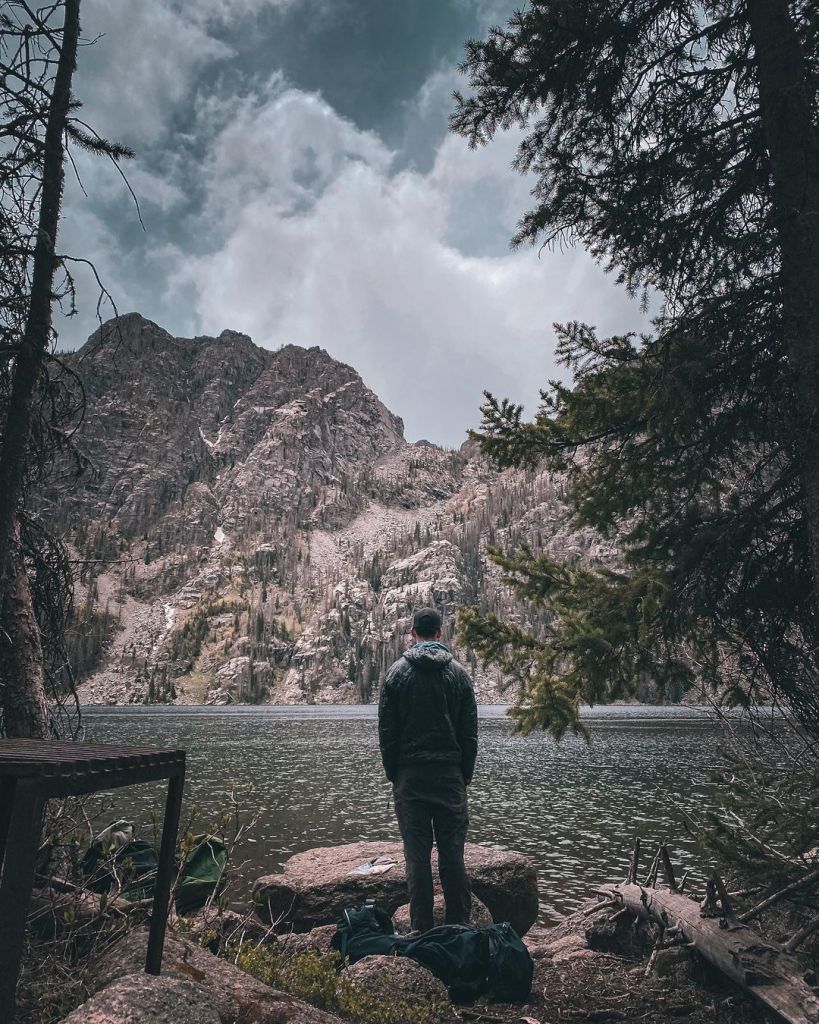
The high country also offers an immense amount of fishing options in the summer in Colorado. It might take a little research to find places like this though, not everthing amazing is cataloged online for your easy access.
- Ridgeway Reservoir
- Lake Granby
- Cheesman Reservoir
- Spinney Mountain Reservoir
- Eleven Mile Reservoir
- Delaney Butte Lakes
- Taylor Park Reservoir
- Twin Lakes Reservoir
- Blue Mesa Reservoir
- Stagecoach Reservoir
- Horsetooth Reservoir
Local Durango Lake Fly Fishing Options
The general list of Colorado lakes above is enough to keep anyone busy for the next ten years. However, we live in Durango, so let’s talk about local Durango lake fly fishing options. We have more than enough in our area to keep you busy for the rest of your life.
- Vallecito Reservoir – Vallecito is one of the more popular lakes for recreation in our area, and for good reason: it’s big. With it’s size also comes a solid fish diversity of rainbows, browns, smallmouth, walleye, and pike. Don’t let it’s size fool you, Vallecito can be one of the best wade-angling fisheries for trout, bass, and pike in our area and the rainbow trout fishing is really good pretty much year-round. There is also a very good boat ramp on the west side of the lake.
- Lemon Reservoir – While the boat ramp has been closed for a few years now, Lemon still remains a good trout fishing lake. With tons of shoreline to access for wading anglers, any watercraft that can be carried to the water by hand is also usable. When the wind isn’t howling in the spring, kayaks, float tubes, SUPs, and canoes are a great way to fish Lemon.
- Lake Nighthorse – Durango’s newest lake! Lake Nighthorse is the closest non-moving body of water at just under a 5-mile drive from downtown. With a daily entry fee, beach, aqua park, and onsite SUP and Kayak rentals; many anglers may be dissuaded from fishing Nighthorse through the summer months. However, this large lake offers plenty of room to spread out and get away from the crowd, as well as a healthy population of rainbow trout and large brown trout. If you are looking for quieter surroundings, spring, and fall are the times to go.
- Pastorious Lake – This is the lake where many local fly anglers cut their teeth fishing lakes. Pastorious is close to town, easy to access, and holds plenty of stocked trout to catch. This is a great lake to learn stillwater retrieves as well as indicator fishing, and you can also find pods of bluegill and bass to catch to your heart’s content. Be on the lookout for a sneaky pike too.
- Electra Lake (when it is open) – Electra is a private lake with public access for a daily fee. As of writing this, Electra is still closed to the public due to dam work. However, it makes the list here as it will open back up again someday, and you should know that it holds an incredible population of browns, rainbows, and a few brookies that get very fat thanks to good food sources including crayfish.
- Haviland Lake – Another great beginner lake. Haviland is a stocked lake and is fishable from late spring through fall, and is a good place to learn to fish from a personal watercraft such as float tube or SUP.
- Andrews Lake – Similar to Haviland but higher in elevation. Andrews is mostly stocked with rainbows that can be pretty opportunistic feeders in the summer when presented with a dry fly.
- Molas and Little Molas Lakes – Molas offers easy access to a mixed bag of cutthroat, brookies, and a few rainbows that are opportunistic in the summer. Little Molas has good cutthroat and brook trout that can often be pickier than those in Molas. Either way, both of these lakes offer the high country lake experience with a parking lot.
- Pagosa Lakes – There are a bunch of lakes in Pagosa Springs. Some are private, some are open to the public. Some of these regulations can change. You are going to have to look them up yourself and maybe call the property owners association. They have good trout fishing though.
- Echo Canyon Reservoir – Echo offers a somewhat mixed bag of rainbow trout and warm water fish and can be pretty fun for beginners. Expect company when fishing Echo.
- Lake Capote – Managed by the Southern Ute Tribe, Lake Capote is seasonally stocked with rainbow trout, brown trout, channel catfish, and largemouth bass. There is a daily entry and fishing fee for non-tribal members and is actually a pretty fun little lake to fish. The size of some of the bass might surprise you but is a really good lake to kick around with a float tube and work on your bug presentation for trout.
- Navajo Reservoir – While not known as a trout fishing lake, there can be a few big browns on that will clobber a pike or bass fly on occasion. This is one of the bigger reservoirs in our area, and the body of water that feeds the San Juan River Quality Waters.
- Weminuche Wilderness and High Country Lakes – There are more lakes in the high country in our area than you could fish in a lifetime. These lakes are best fished from about July through September. The two most popular destinations in the high country are Emerald Lake and Highland Mary Lakes. Emerald is a very popular multi-night backpack trek up the Los Pinos River and used to be a part of the Colorado hatchery program. Emerald is not a secret, so expect to see other hikers and anglers in the summer. The one thing literally EVERYONE says when they come back from Emerald is “I wish I had a boat up there”. Figure out a backpack float tube or SUP option, don’t say I didn’t warn you. Highland Mary’s Lakes is a 4-mile one-way uphill hike that can be done in a day but makes for a good overnighter. Cutthroat, rainbows, and brook trout can be found here.
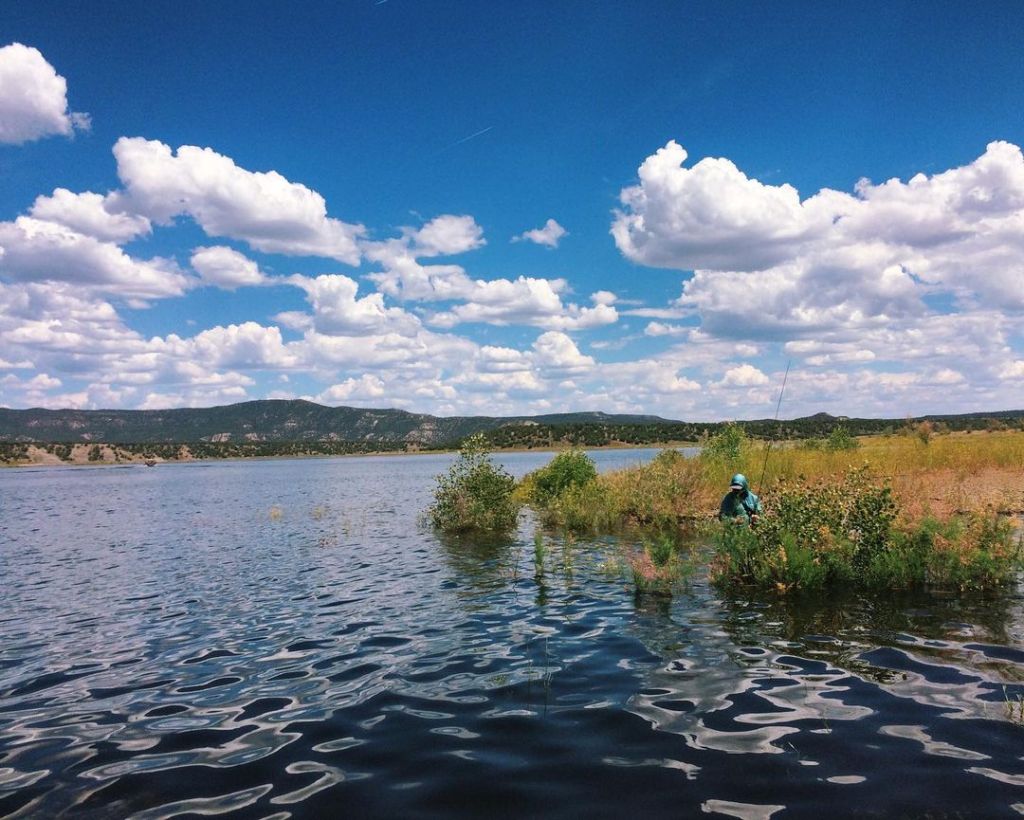
Where to actually fly fish on a lake?
Many lake anglers become overwhelmed as they look out upon the vast expanse of the lake that they have chosen to fish…which is possibly why many fly anglers “don’t fish lakes”. They scared.
There is no need for fear! Walk to the closest shore access, or motor on out to the nearest point that you find interesting, and start there. That is as simple as it can be, start somewhere, and go from there! You will learn a whole lot that way. If you have not had any action, or have seen a fish in 10 minutes, move. Cover a lot of water. Explore as much as you can. Break the lake or shoreline down into smaller sections and cover that section before you change it up entirely.
To make it easier on your mind, and to cut down on the time you may be fishing junk water, here are some key things to look for and to remember when learning how to fly fish a lake:
- Dropoffs – These provide fish with a quick escape to deeper water, yet close to potential shallow water food sources. The transition zone of a dropoff from shallow to deep deserves your time. Step banks often indicate a dropoff for a wade angler, while boat anglers can usually mark them with boat electronics.
- Structure – Anything that breaks up the otherwise consistent lake bottom is an ambush predator’s haven. They can hide from other predators, as well as the prey they are hoping to ambush. We see it a lot with manmade reservoirs that contain very little bottom variance, any kind of change is a place to explore. Big rocks, downed trees, stumps, bushes…abandoned cars, shopping carts…anything. Look for it and fish it.
- Points – We probably could write a whole book on fishing points, but they make for good bait congregating areas, which bring the trout!
- Weedbeds – Weedbeds can be harder to find without a watercraft of some kind, but can still be observed from higher banks (or a plethora of rising trout). Weedbeds are a breeding ground for aquatic insects, which bring all the trout to the yard.
- Inlets – If there is one thing most lake anglers in Colorado have learned, it’s to fish inlets in the spring and fall. Spawning fish congregate in inlets at these times, but in the dead heat of summer, an inlet can provide trout with oxygen, food, and the colder water temps they are looking for.
- Outlets – Outlets are more often found in high country lakes in Colorado, but are a good place for trout to find some moving water. They can also be a place where rainbow and cutthroat trout will spawn in the spring. Some inlets and outlets actually have regulations and seasonal closures to protect spawning fish. Know before you go, and don’t be a jerk and fish to spawning fish anyway!
- Dams – If you are fishing a reservoir, and truly have no clue where to start on such a big body of water, start at the dam. Dams typically have a steep shoreline and a quick dropoff that lends itself well to a wade angler roll casting a bobber rig 20-30 feet out. From spring through late fall, there are typically trout that are cruising the dam looking for a meal. If you have a boat or float tube, it may be a little easier to figure out the depth of fish on a dam, but a watercraft is not imperative here. (keep local laws and regulations in mind before you walk out on a dam).
- The leeward side of a point or structure – Now we are getting techy. Think of the leeward side of a point or structure as the “down river” side. Hungry fish will sit on this side of a point or structure on windy days much like behind a rock in a river. It provides a little relief from the current but is also a great ambush point for food.
- Windward side of the lake – In spring when the lake water is colder, the wind will push the sun-warmed water to one side of the lake. Trout will head to these areas for the warmer water and bugs that get piled up (or hatch) there.
- Mudlines – Mudlines are created by heavy chop from the wind, mudlines warm up a lot quicker in the springtime sun and not only provide warmer water, but a good place for a predatory trout to hide and ambush prey. Are you noticing a trend here now? The key factor is wind. The wind is good, so don’t run from it. Learn to cast with it. Become one with the wind. Pyramid Lake is pretty much built out of wind, and that lake has giant trout.
- Flats and shallows – Now I know I said to look for depths and structure in an otherwise unimpressive bottom, but on occasion in various lakes, trout will come up out of the depths and risk exposure in the shallows for a good meal. It’s almost like spot and stalk bonefish fishing. Streamers, leeches, buggers, or crayfish can work well in these situations, but smaller nymphs, damsels, or dry flies are good when the fish are spooky. Wade slow and keep an eye out, or just chill and wait for them to come to you. This kind of fishing can happen on most lakes when conditions are right, but happens more often in the spring and fall on lower elevation lakes, and midsummer through early fall in the high country.
- Open Water – When trout don’t seem to be hanging out in any of these other areas, sometimes they are just chilling in open water anywhere from 4 to 40 feet in depth in lakes that can push 100 feet deep. You are probably only going to find these fish from a boat with a fish finder and their eagerness to eat may vary. They may be chowing on top water, or sitting at the depths where only a full sinking line can reach.
- Water Temps 55-65 – This is the best temp range to catch trout as they are most likely to feed in this range. It’s not an exhaustive range though, just a place to start. Keep in mind that lakes are a lot different than a river in that in the dog days of summer when the surface water temp is pushing 70 degrees, 10 feet down can be a whole different situation.
The main thing all of these have in common is that they either provide some kind of cover or protection, or it’s where the food is.
When?
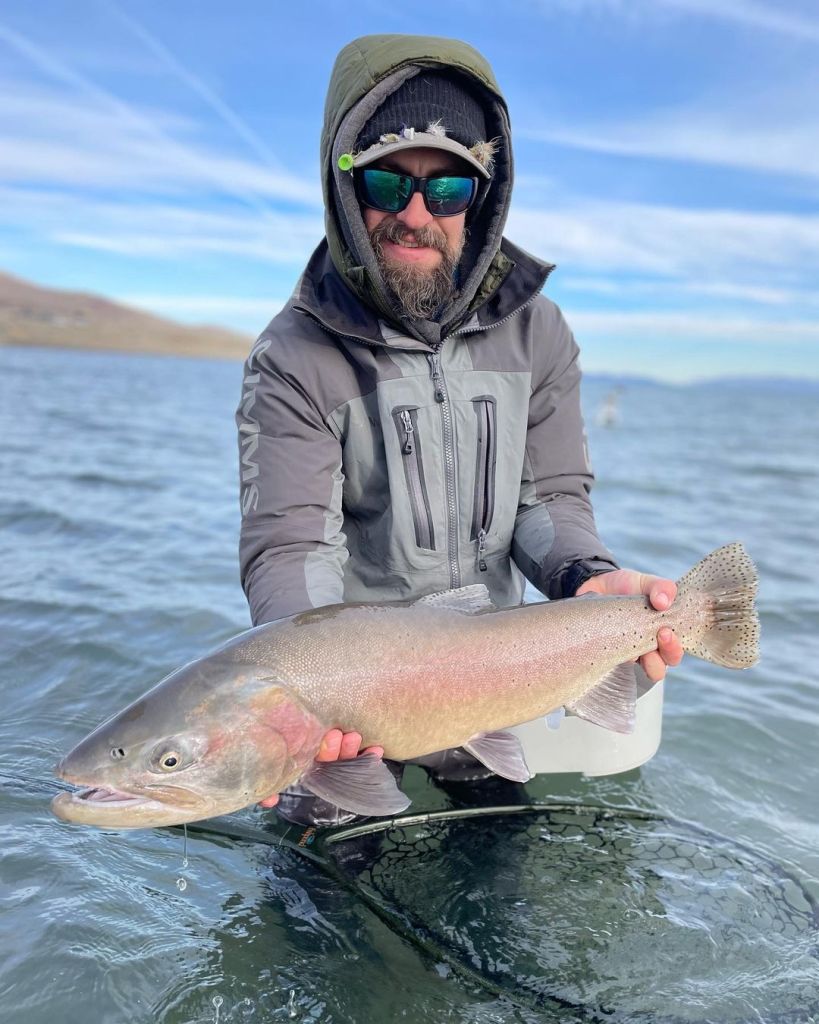
Pyramid Lake is stillwater fishing’s great teacher. Patience, perseverance, and proper presentations are key, but the lessons learned at Pyramid are applicable almost anywhere where trout live in lakes.
When can you fish a lake for trout? Pretty much year-round (ice fishing). When should you fish a lake for trout? As a fly angler, generally, spring at ice-out through early winter before lakes freeze can yield good fishing. Every lake and every elevation is different though and has its best times of the year to fish.
The lower a lake sits in elevation, the longer the season. The higher in elevation you go, the shorter the season can be (in Colorado at least).
Spring
As stated earlier, When lake water temps begin to creep above 50 degrees, trout become more active with the best feeding temps from 55 to 65 degrees. This is only a general guideline as ice begins to recede from the banks and through ice-off, trout may become ravenously active and eat any fly presented to them for a week or more. This time of year is often overlooked by many fly anglers though it is a great time to fish. Streamers and wet flies on slow sinking lines, midge rigs, and even bobber rigs make for really good fishing in early spring.
Spring is when many rainbow and cutthroat trout begin to stage close to river inlets before they move upstream to spawn. Avoid spawning redds in rivers and creeks, but working a spring inlet on a lake is a good way to find big fish, and even non-spawning browns looking to fill up on dropped eggs or smaller fish. Post spawn, rainbow and cutthroat trout will be ravenously hungry and looking for easy meals.
Throughout the rest of spring into early summer, lower-elevation lake fishing will only get better with each warming day using dries, nymphs, and streamers. Once we start to see runoff blow out rivers and creeks, the best time to fish these lakes has already begun and will continue through the summer.
Summer
Late spring through early fall is hatch time on lakes. Be prepared with a good assortment of dry flies including callibaetis, chironomids, damselflies, and caddis. Mid to late summer also will have showings of terrestrials such as ants.
From about mid-June through mid-September (give or take) is the best time to seek out high country lakes. Before or after and these lakes may still be frozen, or just too cold to catch trout at elevation. Within this magic backcountry window lies some of the best fishing the Colorado high country has to offer. The Weminuche wilderness is in our backyard, so grab a map and go! Trout in these lakes are opportunistic and may eat any well-presented dry fly. However, make sure to have scuds, leeches, small soft hackles, buggers, damselfly nymphs, or chironomids as some of these lakes will boast larger, and pickier, cutthroat.
Coincidentally, as the high country lakes come into their best fishing conditions, our lower elevation lakes may become a bit more difficult to catch trout, as the upper water temps may have pushed past 70 degrees. Smallmouth bass fishing might be fantastic, but cooler days in late summer and early fall will procure better trout fishing.
Fall
Early fall may have a few good days left in the higher-elevation backcountry lakes when the lower-elevation lakes may stay warm. Cooler nights will bring lake temps down and fishing can pick up exponentially in lower elevation lakes, yet shutting down some in the higher reaches. Hatches of midges and a few mayflies may still be around, and streamer fishing on lakes can be pretty good in the fall. Browns will begin to stage in the inlets pre-spawn and may be charged up enough to hammer a streamer.
As temps cool through fall, indicator rigs or sinking lines may be more in order to entice fish. Many local lakes have some fantastic fly fishing in November and December before the winter freeze. Don’t tell anyone.
Winter
Ice fishing time, unless your favorite lake does not freeze. Drop a Euro jig through the ice with your ice rod. It’s still fly fishing, right?
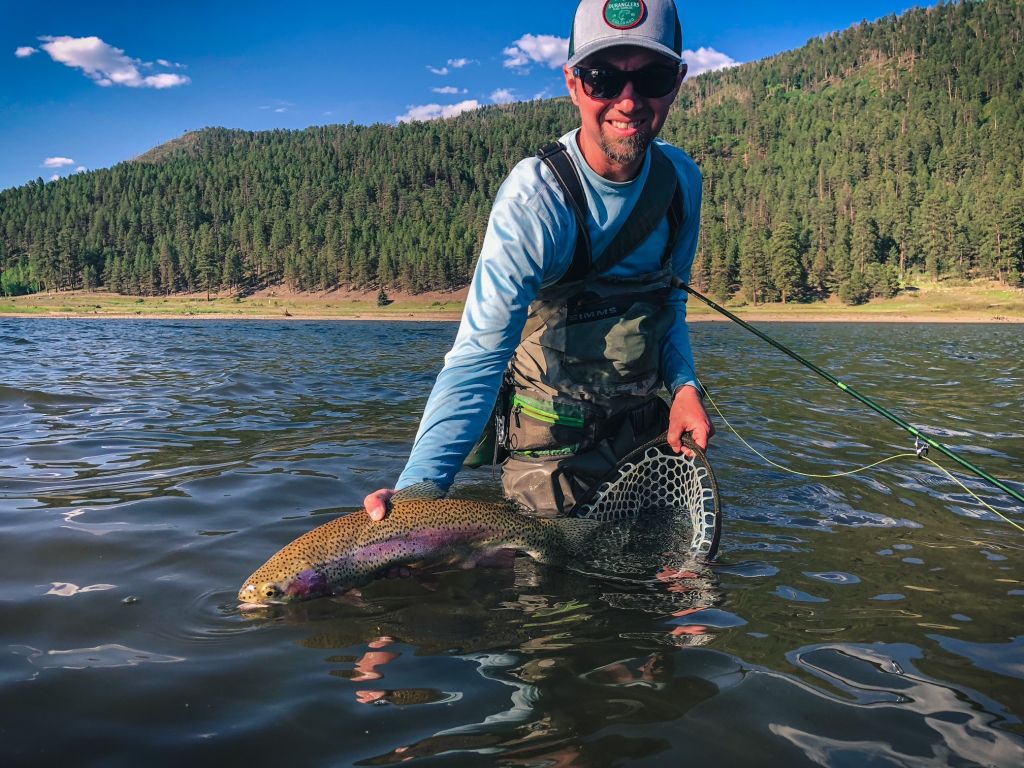
What?
Now that we got the why, where, and when out of the way; let’s talk about “the what”. What do you need to fly fish in a lake or reservoir? As we stated from the outset, all you really need to get started is just a few flies and your trusty 9 foot 5. Add a leader, tippet, and indicator, and you can indicator fish almost any lake to your heart’s content and catch a pile of trout to boot! (we will the how of indicator fishing next section).
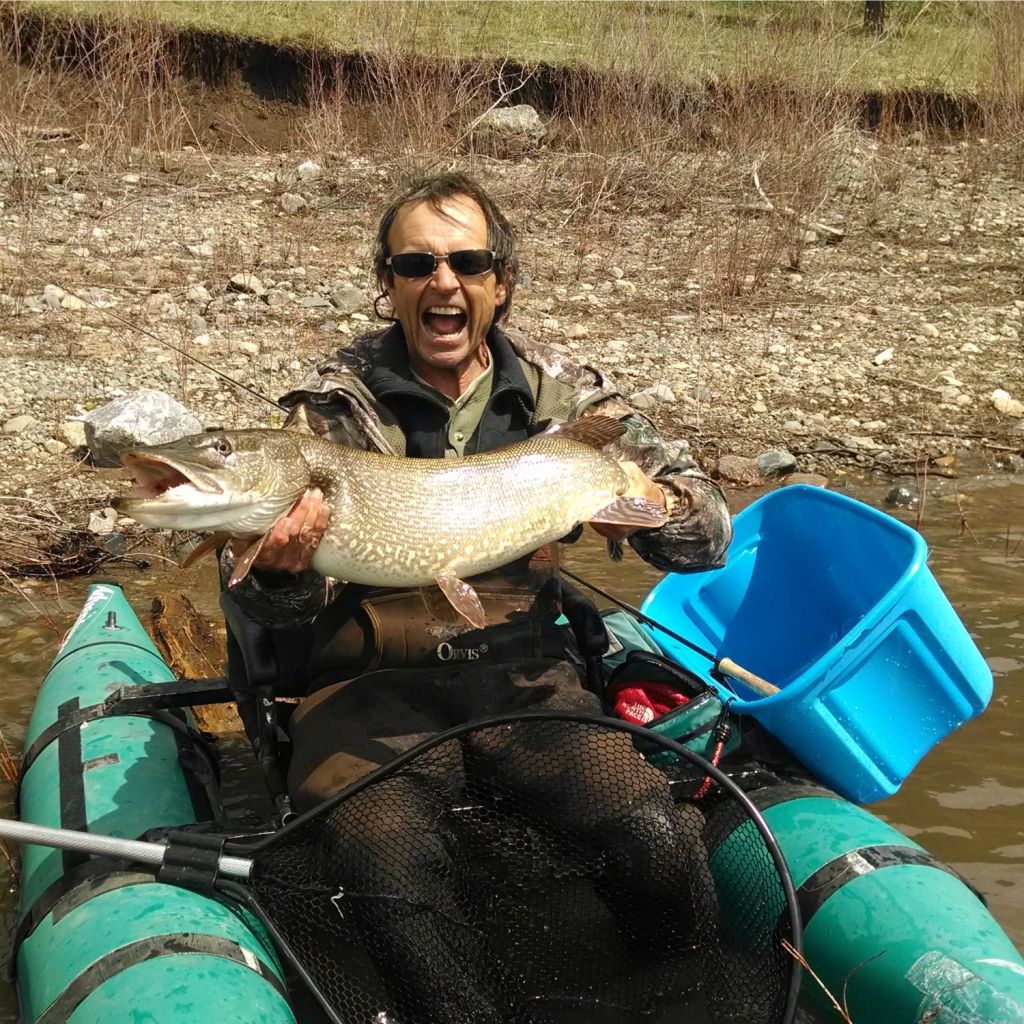
You can do a lot with even a little float tube or pontoon boat.
However, as with any fly fishing pursuit, there is specialty gear for the diehard angler to maximize their time on the water.
Watercraft – Ok, so we know not everyone can go out and buy the latest Ranger with all the bells and whistles and 200 hp motor. Nor do you need to. However, there are times when fishing a lake that you may wish you had some form of watercraft to get to the rising trout that seem to sit 5 feet past your maximum casting distance. Of course, a boat with a motor and trolling motor is the best watercraft option you could ask for, but you are by no means out of luck without one. Anything that floats, gets to the fish, and you can cast from is useful such as a drift boat, raft, SUP, Kayak (especially a fishing-specific kayak), canoe, or our personal favorite: a float tube.
Float tubes, or kick tubes, are extremely useful for the fly angler as they are relatively inexpensive, light, easy to transport, and propelled by your feet with kick fins! The kick propulsion is key as it frees up your hands to cast, manage your fly line, and catch fish! A huge benefit to float tubes is that they can be transported in any kind of vehicle, inflated quickly, and dropped into any body of water without the need for a boat ramp. While you may not have the speed or maneuverability of a motorboat, float tubes can be used almost anywhere. With more bodies of water in Colorado shutting down motorized traffic, self-propulsion is becoming more important than ever.
For the average angler, the Outcast Fish Cat 4 Deluxe is just about the best all-around float tube for our area, but the Fish Cat Cruzer is a really nice upgrade with the added oars to aid in moving around larger bodies of water. Both of these tubes also have a “big and tall” version for larger anglers. Add kick fins and a PFD, and you almost don’t even need a fly rod to catch fish (more on that in a bit).
Fly Rods – Again, a 9 foot 5 weight can work great, but anything from a 4 weight for smaller high country lakes to 7 weight for large water situations in 9 to 10-foot length is ideal. Depending on the lake, an 8 weight may even be called for. Longer length rods are preferred by many stillwater anglers as extra length helps anglers achieve longer casts with less effort through the day, makes line pick up easier off the water, and is a good tool when fishing from a float tube as you are situated closer to the water. Faster action rods are nice for throwing longer casts, and especially with any kind of sink tip or full sink line.
Three of our favorite stillwater trout rods are the Sage R8 CORE, G. Loomis NRX+, and the Orvis Helios 3D; but anything with some power in a 5-7 weight and from 9-10 foot will suit you well. The Sage FOUNDATION is actually a really good budget big water option as it boasts some solid backbone and line speed for the price.
Fly Reels – The adage for trout reels typically goes something like: “It’s just a fancy line holder”. In lake fishing, trout have a lot more area to run, and having a good drag can mean the difference between a caught fish and a lost fish. Get a reel that balances your rod well, especially if it’s a longer rod, and has a good drag. Durability is always good, so go for a machined reel when you can, however many anglers do like the versatility of a cast aluminum reel with multiple spools for different lines and sink rates. Use what works for you with some kind of halfway decent drag.
Our favorite stillwater reels are the Ross Evolution R for super beefy drag, Sage SPECTRUM or Orvis Hydros reels for solid all-around use, or the Redington RUN for a good budget option.
Fly Lines – Time to get a little techy. No other style of fly fishing has more fly line options than trout fishing on lakes. This is possibly due to the fact that for every region in the world, anglers have come up with slightly different ways to catch trout in stillwaters. This can lead to immense confusion, but to make it super simple we recommend using your normal weight forward floating line, adding an intermediate sinking line after that, and then a full faster sinking line if you feel you need it later on.
- Floating Lines – Your favorite weight-forward floating fly line will get a whole lot of use on a lake. Our favorites are the RIO Gold taper or the SA Amplitude Infinity Fly Lines for when you want to fish dries, nymphs, or streamers. For more application-specific fly lines, check out the RIO Elite Indicator fly line or the Scientific Anglers Amplitude Anadro Indicator fly line.
- Intermediate Lines – If you only add one additional fly line to your lake arsenal, you want an intermediate sink. While it does not sink fast as some, it sinks. Just use the countdown method for deeper depths before you start your retrieve (cast, count to 5, 10, 15, etc.). 1.5ips (Inches Per Second) is about standard and our favorite is the SA Sonar Stillwater Clear Camo.
- Full Sink Lines – These are for when anglers want to get deeper quicker, and come in a variety of sink rates. The SA Sonar Stillwater Seamless Density and Scientific Anglers SONAR Titan Int – Sink 3 – Sink 5 lines are our favorites, but the RIO Mainstream Full Sink Type 3 is a really good budget option as well.
Leaders – Another techy subject that can go deep in the weeds. Keep it simple, 9-12 foot 2X-5X leaders for indicator rigs, heavier 4-9 foot leaders for streamers (shorter for sinking lines), 2x-4x 9-12 foot leaders when stripping smaller flies on a sink tip. Having a few 9-foot 3x leaders is as easy as it gets. You can always add additional 3x or 4x tippet for dries or deeper nymph rigs or cut them back for throwing heavy streamers on sinking lines.
Tippet – Match your leaders, 1X-5X, or 10, 15, and 20lb Maxima. Fluorocarbon can actually make a huge difference on indicator rigs as trout have plenty of time to check out your flies.
Indicators – An indicator that won’t get swamped by wind and waves is another must. Our favorite lake indicators are Tube Tear drop indicators for lighter rigs as well as Corqs, Thingamabobbers, and AirLocks for heavier setups. However, there are a few stillwater specific indicators out there.
Weight – If you don’t want to jump full in on a sinking line, Versi Leaders are a good option, because you should already have split shot, wich also works in a…pinch…(see what I did there).
Waders and Boots – Last on this list? Waders and boots are actually pretty vital if you don’t have a boat and need to wade out just a little further to where you are seeing fish. However, in many reservoirs in Colorado, wading might give you 5 extra feet before you are too deep with steep dropoffs, so just figure out how to get 5 extra feet of casting distance. We actually are big fans of the Grundens Deviation 6 inch Ankle boots for shore or boat fishing because of this. Choose your gear according to where you will be fishing
Layers and Rain Gear – Colorado can go from 95 and sunny to 60 with rain and blowing 30mph in a matter of minutes. Good fleece layers and a rain jacket and even bibs are almost a necessity. On a boat or from shore, come prepared for the worst to fish the best.
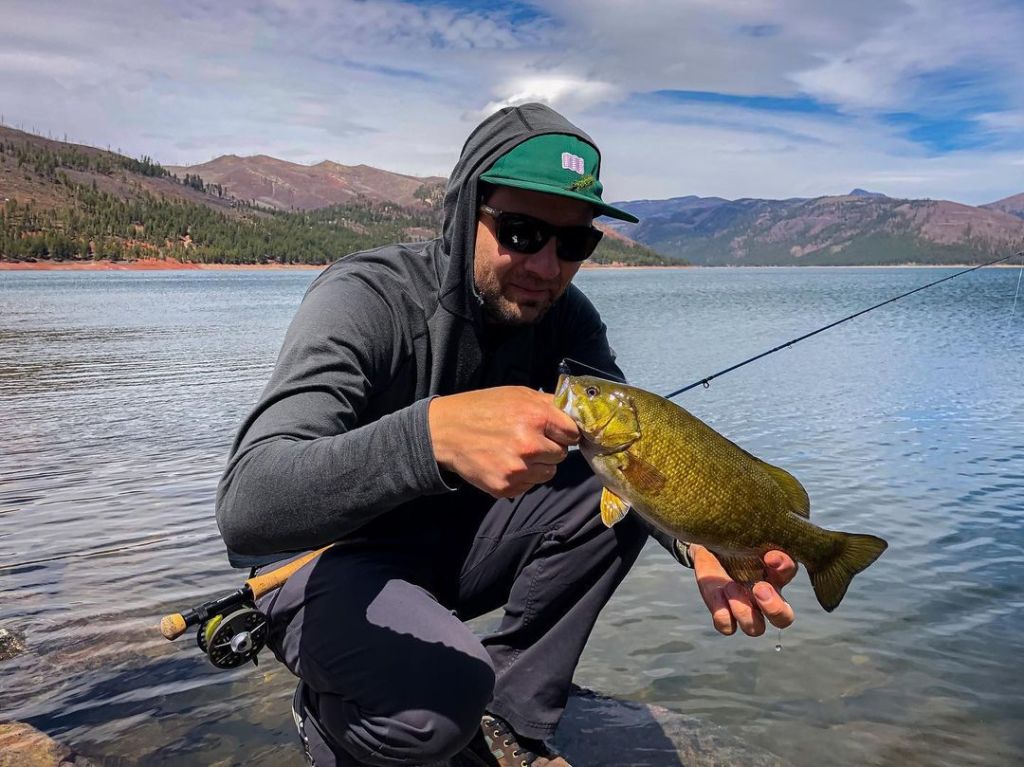
When fishing any lakes with streamers for trout, and smallies are around, it’s good to size up your tippet a little.
Flies
Let’s start off easy with flies, and then go a little more complex. Your current selection of dries, nymphs, streamers, and wet flies will probably cover a good portion of the situations you find yourself in. Honestly, if you only had these standard 8 flies in a variety of colors and nothing else, you would probably do pretty well on any lake for trout. Hare’s Ear #10-18, Soft Hackle Peacock #12-16, Parachute Adams #10-20, Wooly Bugger #6-12, Simi Seal Leech #8-12, Elk Hair Caddis #12-18, Zebra Midge #14-18, and then Stimulators including black OR some kind of flying ant #12-16 (it was a toss-up).
80% of the time this fly assortment flies will work every time.
Though not exhaustive, here is a quick rundown of some trout food sources you will find on many of our lakes in our area along with a few corresponding flies to “match the hatch”.
(We also have custom fly assortments available for lakes and stillwaters to make it quick and easy to put together the perfect fly box for where you will be fishing.)
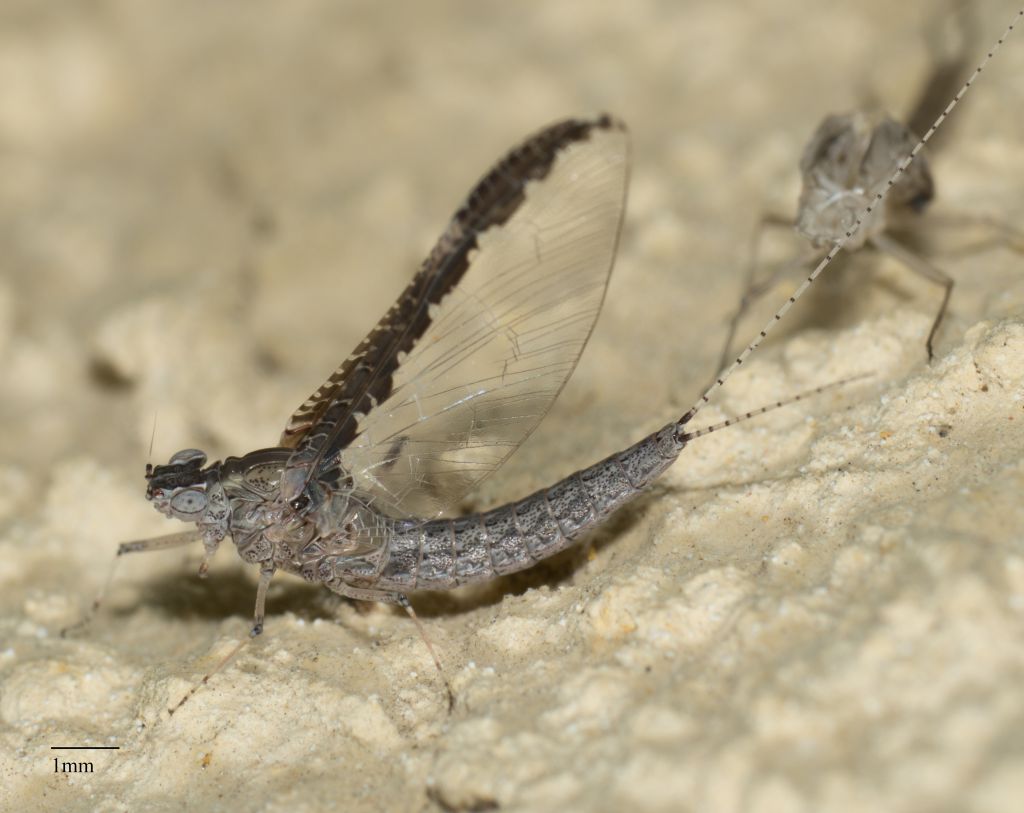
Callibaetis adult, thanks Wikipedia commons.
Callibaetis – A fan favorite, callibaetis compromise a genus of mayflies that hatch in lakes and can provide some of the most exciting dry fly fishing on a stillwater. Better yet, they have a summer-long hatch window and can show up May through August throughout the West. Nymphs can be fished under an indicator, or on a slow strip with a little weight or sinking line.
Sizes #12-16
Dries: Parachute Adams, Callibaetis May Cripple, Guide Chute Hare’s Ear
Nymphs (tied thinner): Grey Baetis Nymph, Hare’s Ear Nymph, Soft Hackle Hare’s Ear, Whitlock’s Red Fox Squirrel.
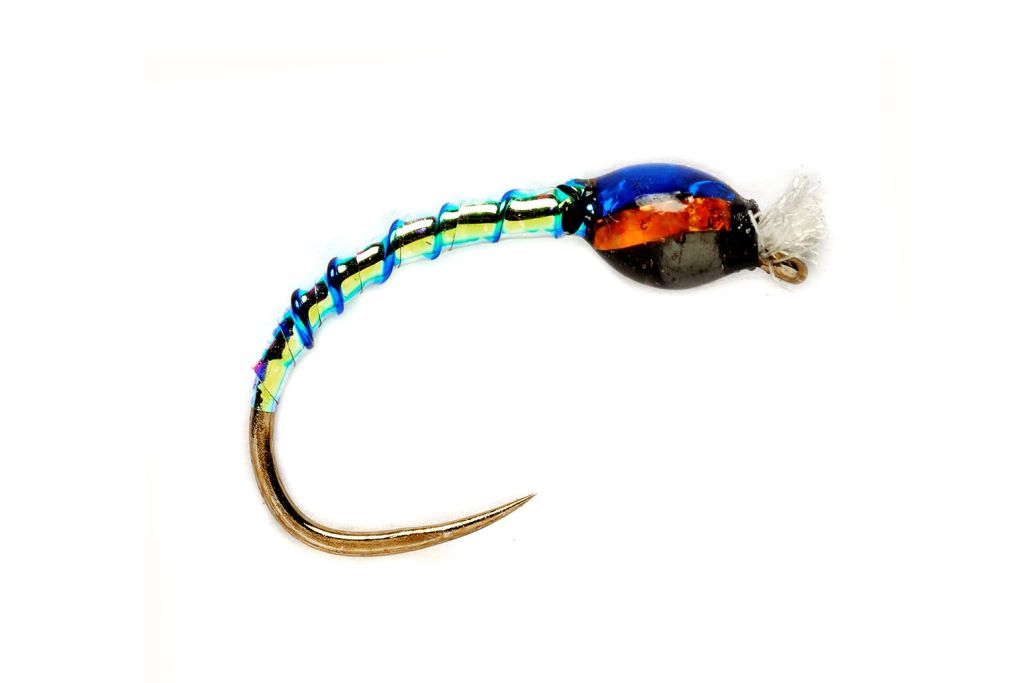
Oil Slick Buzzer
Chironomids – These can be lake “workhorse” bugs in the west and can provide a large portion of a trout’s diet on many lakes. Though Chronomids are a midge, they might surprise the new stillwater angler with just how big they can get. Unlike the classic size 24 midge often seen on tailwaters, chironomids can push up to a size 6 at times, though they average 12-16 in Colorado. When you feel like you are getting swarmed by mosquitos but not getting bit, think chironomids. Annelids are typically fished under an indicator.
Sizes #12-18 are the most common
Dries: Parachute Adams, Griffith Gnat, Mosquito (you can cut the bottom hackle so it sits flush in the film).
Nymphs: Oil Slick Buzzer, 3D Glass Chironomid, Amber Sexi Bomber, Red Chirono Cone, Annelids.
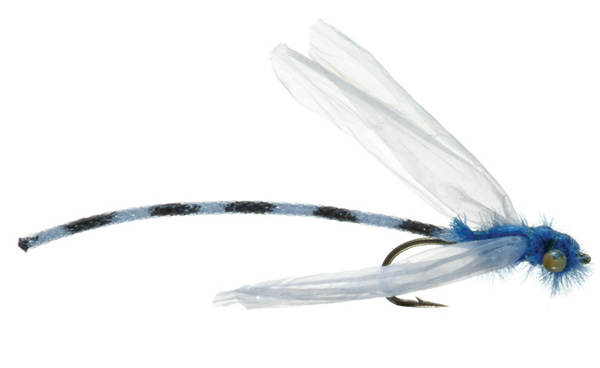
Summer on any lake wouldn’t be complete with out a few of these guys flying around
Damselflies – While most people don’t remember their name, almost everyone remembers what they look like: “There were these blue things flying around”. Damselflies are another staple lake trout food throughout the US. Mostly known for their blue adult stage when trout are violently crushing them on the surface June through August, Damselfly nymphs can be fished almost year round. Slow strips with pauses are how trout like them on floating and sinking lines, but can also be fished from an indicator. The fun comes when trout are in shallow water and can be sight fished with unweighted nymphs moved slowly.
Sizes 12-16 are the norm
Dries: Blue Deer hair Damsel, Egg Laying Damsel, Adult Damsel, Adult Foam Damsel, Braided Butt Damsel
Nymphs: Olive Marabou Damsel, Ultra Damsel Nymph, Damsel Bugger or small olive buggers

Scuds only work on lakes so don’t you go try and fish something like this on a river like the San Juan River Quality Waters in a size 18-22 in olive or grey. It just won’t work.
Scuds – Lakes with some aquatic plant life more than likely have some kind of scud or sowbug swimming around. Pull out some of that seaweed-looking stuff in the spring and see if a few scuds aren’t kicking around. Scuds are present in many elevations, even the high country.
Sizes 12-22
Nymphs: Ray Charles, Scud, Flashback scuds in olive, grey, pink, orange, and white
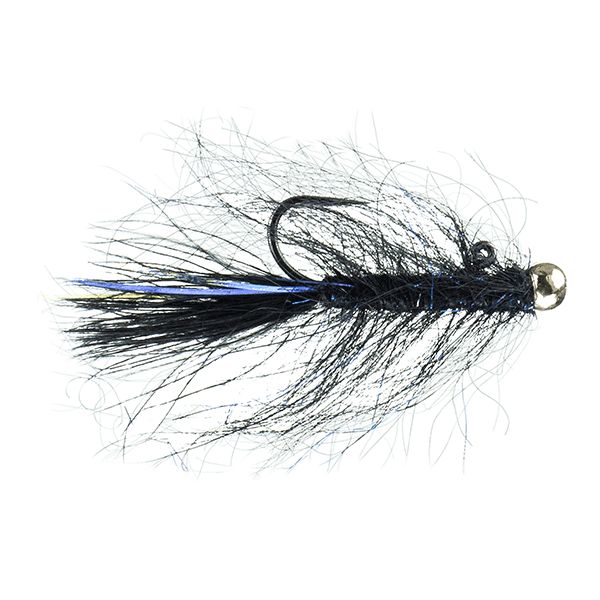
The Balanced Leech has quickly become a stillwater favorite pretty much everywhere.
Leeches – Though not always obviously present, leech patterns still account for a large swath of trout caught in lakes throughout the world. Fish under an indicator, balanced style with occasional twitches, on the strip with weight or sinking line, or even trolled in your float tube. The famous Simi Seal Leech also is a good bugger alternate and can imitate a variety of trout foods.
Sizes 6-16
Patterns: Mayer’s Mini Leech, Simi Seal Leech, Balanced Leech, Goat Leech, Squirrel Leech, and Bunny Leechs in almost any color such as white, ginger, olive, blood, black, and brown.
Baitfish – Do you even huck meat bro? Large trout get large by eating smaller fish. There is a variety of baitfish throughout Colorado lakes that trout will forage on, and it’s always good to have a few baitfish patterns in your box. It’s good to have a selection of colors and sizes which can range from hyper-realistic to more flashy and less imitative to provoke an aggressive strike. Every lake may have its own species of baitfish such as sculpin, darters, shiners, chubs, bluegill, small kokanee salmon, or suckers; but if you are targeting trout you can typically assume baby trout are around and will get eaten. We tend to err on the side of small to medium-sized streamers as opposed to large streamers on lakes (but follow your heart).
Sizes 4-12
Patterns: Belly Scratcher Minnow, Trout Parr, Triple Double Rainbow, Thin Mint, Low Fat Minnow, Micro Dalai Lama, Mini Dungeon, Mini Peanut Envy, Barely Legal, Drop Dead Minnow, Belly Ache Minnow, Flash Fry
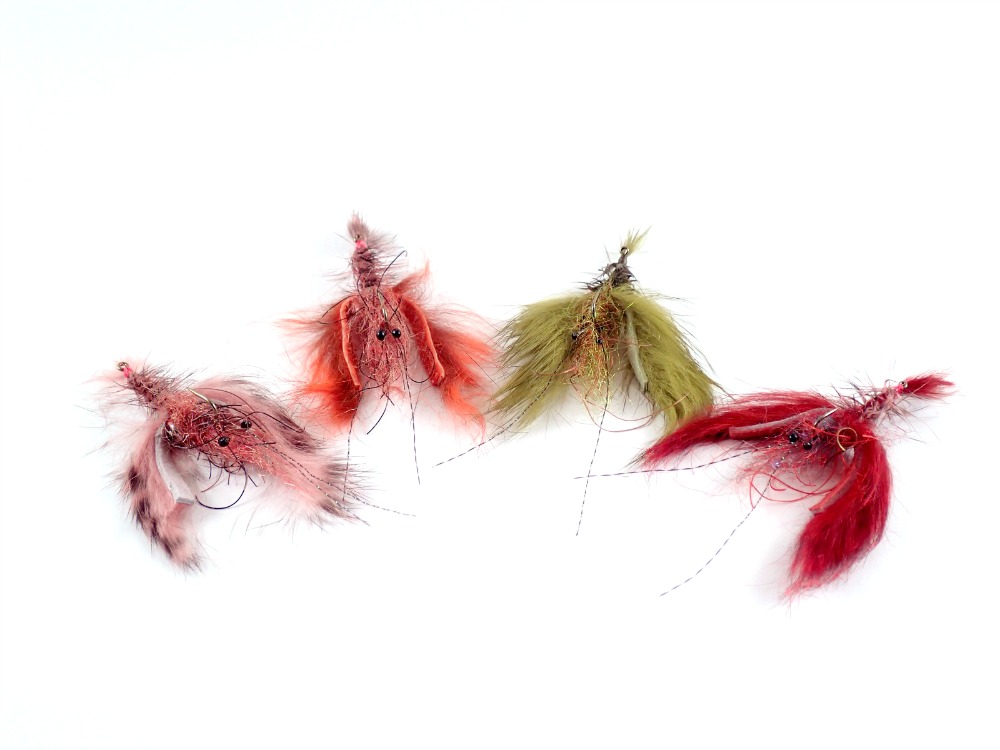
Crayfish patterns are highly underrepresented in most lake anglers’ fly boxes.
Crayfish – It seems that many prospective lake anglers are shocked to learn that trout eat crayfish, and this food source is not merely targeted by bass. Crayfish provide a lot of protein to growing trout, and when these freshwater crustaceans are abundant, trout grow large. On windy spring days when waters are churned up and it seems too rough to take a boat out, walk the shore, and cast a Fighting Craw into the chop and mudlines. Big fish will cruise these areas looking for churned up craw daddies to chow.
Sizes 2-12
Patterns: Mardi Craw, Ritt’s Fighting Craw, RIOs Cray Cray, Belly Crawl Nymph, Meat Whistle, Sweet Baby Cray, Son of Crazy Dad
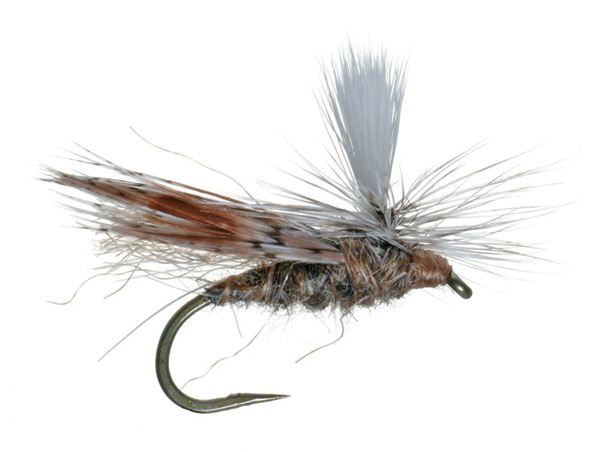 Caddis – While caddis are not as easy to predict on lakes as other hatches, they still will hatch depending on the lake and conditions. You may also find a favorite lake with larger-than-average caddis. It never hurts to have an olive caddis pupa-ish looking wet fly and an Elk Hair Caddis dry in your box.
Caddis – While caddis are not as easy to predict on lakes as other hatches, they still will hatch depending on the lake and conditions. You may also find a favorite lake with larger-than-average caddis. It never hurts to have an olive caddis pupa-ish looking wet fly and an Elk Hair Caddis dry in your box.
Sizes 10-20
Dry Patterns: Elk Hair Caddis, Parachute Caddis, Tan E/C Caddis, Sedgehammer, Goddard Caddis
Nymphs: Holy Grail Caddis, Barr’s Graphic Caddis, Bubble Emerger, OCD Caddis.
Terrestrials
Attractors/wets and dries
mice
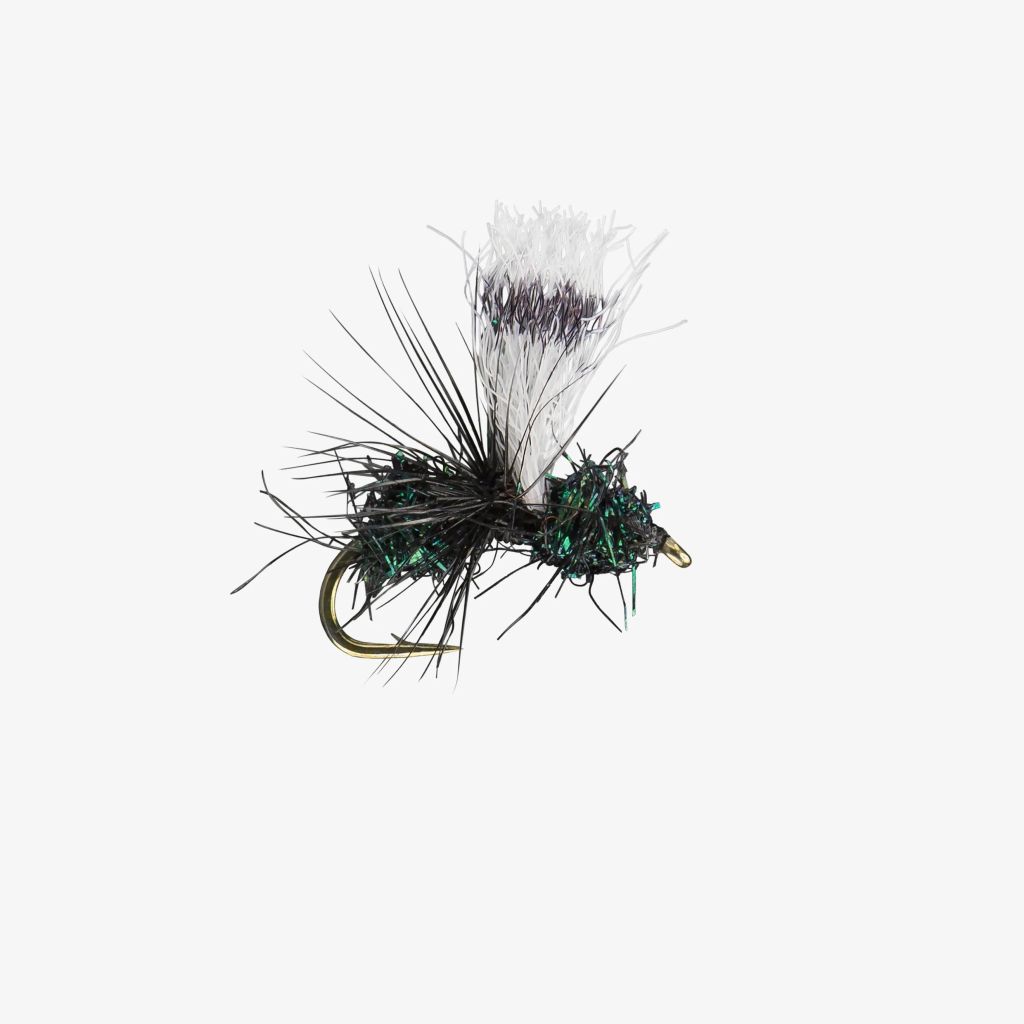 Terrestrials – These can play a huge role in the lifecycle of a trout through mid and late summer on low and high-elevation lakes. Common terrestrials include ants, beetles, hoppers, moths, crickets, and cicadas as they often fly or are blown into lakes by gusts of wind.
Terrestrials – These can play a huge role in the lifecycle of a trout through mid and late summer on low and high-elevation lakes. Common terrestrials include ants, beetles, hoppers, moths, crickets, and cicadas as they often fly or are blown into lakes by gusts of wind.
Sizes 6-18
Dry Patterns: Glitter Ant Flag, CFO Ant, Para Ant, Fathead Beetle, Chubby Chernobyls, Stimulators, Red Leg Hopper, Lil Hopper Juan, Morrish Hopper, Psycho Ant, Sweetgrass Hopper, Spruce Moth, Orange Mr. Miller.
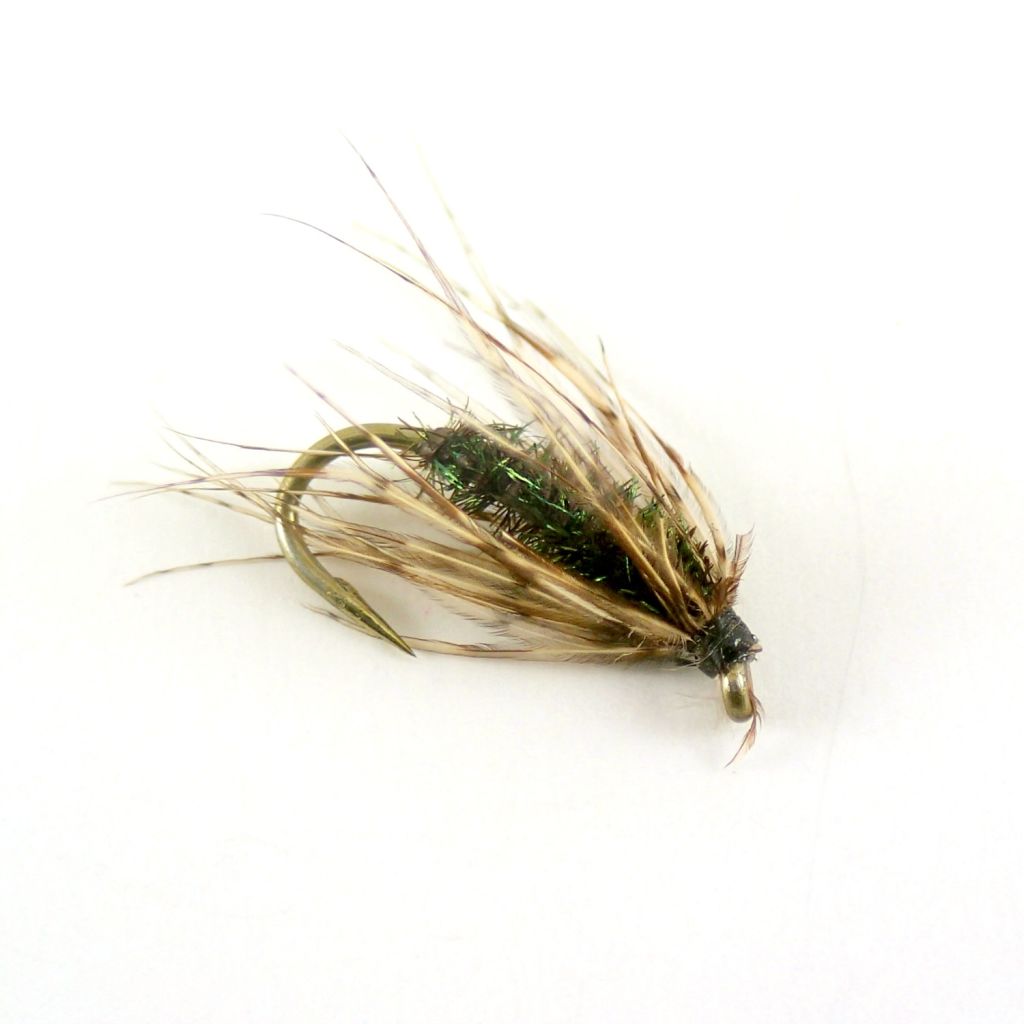 Attractors – ‘Attractor’ is a general term for flies that don’t imitate anything, yet seem to attract fish in droves. Attractor dries can be very effective on certain high country lakes in the summer. When fishing under the surface, and you just are not sure what they may be eating, a favorite wet fly dropped off the bend of a leech or bugger can make all the difference.
Attractors – ‘Attractor’ is a general term for flies that don’t imitate anything, yet seem to attract fish in droves. Attractor dries can be very effective on certain high country lakes in the summer. When fishing under the surface, and you just are not sure what they may be eating, a favorite wet fly dropped off the bend of a leech or bugger can make all the difference.
Sizes 6-18
Dry Patterns: Neversink Trude, Purple Parachute Adams, Royal Wulff, Hippy Stomper, Dry Muddler
Wet Flies: Partridge and Orange or Orange, Partridge and Peacock Wet Fly, Guide’s Choice Hare’s Ear, Whitlocks Red Fox Squirrel Nymph, Pheasant Tail, Spider style wet flies
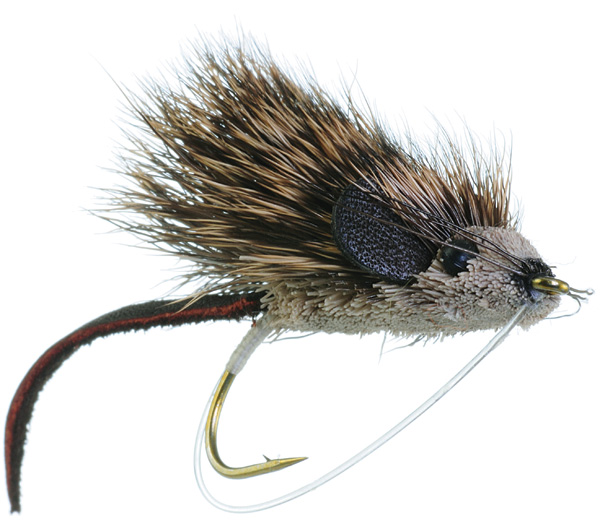 Mice – The ‘hail mary’ of lake flies. There are times when a mouse fly does not work…and then there are other times when you question why you never tied on a mouse fly. High country lakes in the summer are a prime spot to test the mouse. Just remember, you have to fish a mouse fly to catch a fish on a mouse fly.
Mice – The ‘hail mary’ of lake flies. There are times when a mouse fly does not work…and then there are other times when you question why you never tied on a mouse fly. High country lakes in the summer are a prime spot to test the mouse. Just remember, you have to fish a mouse fly to catch a fish on a mouse fly.
Patterns: Mousketeer, Hemorrhoidal Mouse, Mouserat, Midnight Express Mouse, Morrish Mouse.

How?
Last, but certainly not least, how do we fly fish a stillwater? This is perhaps the biggest question, and the answer continues to evolve for us even after 40 years in business. New flies, new lines, new gear, and new techniques show themselves to be very productive each year. There is one consistency in lakes and a vital difference between lakes and rivers. In a river, the water moves, and the fish stay relatively stationary as their food is brought to them with the flow of the water. In a lake, the water stays relatively still, and trout move in order to forage for food.
Sometimes all it takes is waiting for the fish to come to you in a lake. Sometimes you have to keep moving to find the right area. There are a few ways to approach (or find) fish, and then there are different ways to target them. Let’s talk about a few.
Ways to approach (or find) fish

This looks like a solid drop-off to find a trout in the high country of Afghanistan.
On Foot – For the everyday blue-collar fly angler, simple is best with the walk and wade maneuver. Park your truck and start walking. Of course, the first thing you should look for is trout. See some rising? See them cruising the shallows? Start there and target those fish…
More often than not, seeing fish is easier said than done because they don’t want to be found, and all the right techniques in the wrong spots won’t yield a thing. See the ‘Where to Fly Fish on a Lake’ section for an in-depth look at what to look for.
However, (as a beginner) when you come to a brand-new lake, see no fish, question yourself entirely, and just have no clue where to start, do this: look for a steep bank dropoff (or dam) that has a steeper angle into the lake and start there. The steep bank angle typically means depth closer to shore, and trout like a little depth for cover and movement. Deeper water within casting distance is your foundation, and from there you can break the shoreline down into smaller sections and cover that section before you move to a new area. Keep it simple to start out and rig up with a 2-fly indicator rig. A soft hackle Hare’s Ear and Chironomid nymph with some weight under an indicator at about 6-8 feet is one of the best starter rigs for a dropoff, but use your best judgment for the water. (Nymph rig setups are covered below)
The first thing many anglers will notice about this spot with a steep bank angle is the backcast room is very limited. This is where a good roll cast becomes pretty vital, and you are in a perfect spot to practice. Work on getting a good roll cast out to about 30 feet (or more if you can) by stopping your rod high and casting at the space above the water, not down at the water itself. Let your indicator rig settle and now it’s time to sit back and see where your indicator drifts. Small currents or wind will actually give your rig a ‘drift’ similar to an extremely slow river. You may even notice a bow in your line, which is a good time to mend ‘upstream’. Your mend will twitch your flies a little, which may entice a strike. If at any point, your indicator twitches, moves of its own accord, or goes under, set the hook just like you would if you were dunking worms at the farm pond.
This is a very, very basic starting point, but you have to start somewhere. Dams and dropoffs are also good places to fish sinking lines with wet flies, nymphs, or streamers stripped back to you, more on that in a moment. Another great starting point for the uninitiated is river and creek inlets where fish may stack up pre-spawn, post-spawn, or just when they want colder, oxygenated water that might carry a few bugs into their face.
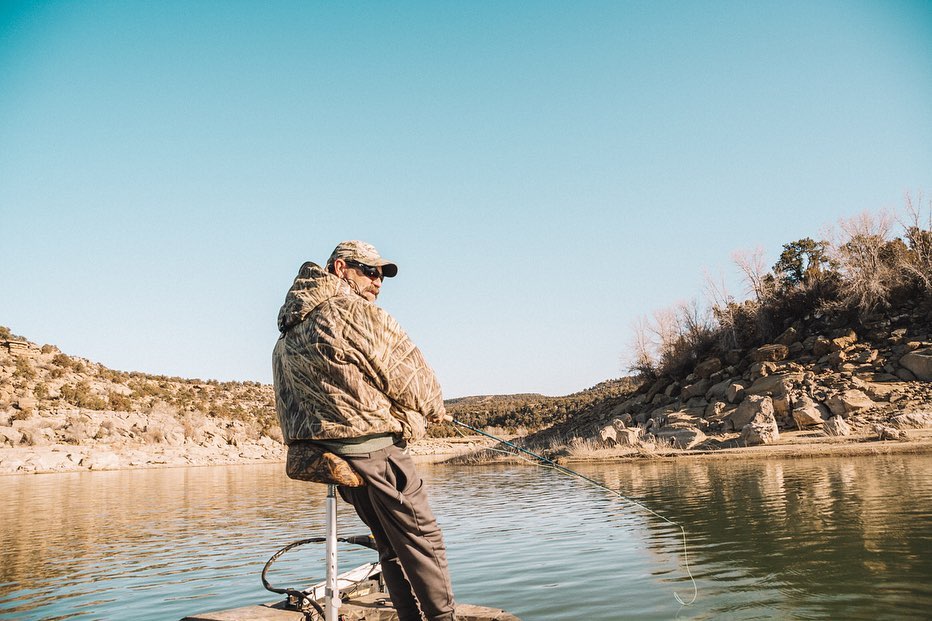
Get a boat, catch boat fish. Simple as that.
On a Boat – The problem with fishing from the bank of a lake, even with waders, is that it seems like fish are sitting only a mere 10 feet past your furthest cast. This is a feeling everyone experiences, no matter how far you can cast so you should probably get a watercraft. Something, anything that floats and gets you to the fish will work.
As we stated earlier, the lowest barrier for entry for a watercraft (without getting a little dicey) is a float tube with your feet as the motor with kick fins. The beauty of a float tube is that you almost don’t even need to know how to fly cast. Strip off a bunch of line, dump it in the water, and start kicking. A rudimentary way to troll flies on floating and sinking lines, but immensely effective, and a stillwater staple technique.
The thing about any kind of watercraft, be it float tube, SUP, John Boat, jet bass boat, kayak, canoe, flats skiff, drift boat, pontoon, or Wal-Mart raft; a new dimension of fishing stillwaters will be open to you. Traversing between locations becomes quite a bit easier (wind permitting), and the boat can even be used as a trolling or drifting tool to cover more water, which is the key to finding more fish!
Bigger budgets bring bigger boats, and with that comes new technology such as trolling motors and fishing electronics that really cut down on the curve of finding trout. We won’t be covering fishing boat tech in this article, just keep in mind that fish finders and trolling motors can be added to lots of inexpensive watercraft: kayaks, personal kick pontoons, paddle boats, small aluminum boats, or canoes. If you have a Gheenoe you want to get rid of, shoot me a message.
You have a few more options for techniques to use from a watercraft than you do from the shore, but the fundamentals are the same. Pick a likely spot on the lake (see above for areas to look for), and go from there.
However you choose to reach the trout, by boat or on foot, most fishing techniques remain the same. However, there are a few additional techniques available to the boat angler such as trolling, wind drifting, and even loch style techniques.
Stillwater Fishing Techniques
Indicator fishing
As you have probably gathered, fishing with an indicator is neither the most glamorous nor is it the most exciting…unless of course, you are getting a bite on every cast within seconds, then the bored change their tune. Indicator fishing can be done from the shore or from a boat, and resembles how we all learned to catch fish: with a bobber and worms.
The ideal way to fish an indicator rig is to suspend your flies just above the bottom, where most of the cruising fish can be found. There will be times in heavy hatches when you can fish a short indicator rig of 3 feet or so when trout are looking up to emerging chironomids or other bugs. Unlike a river, you have some room to breathe on your rigging and can (in most places) fish up to 3 flies 3 feet apart from each other to cover a few columns of water. You can fish a pretty standard nymph rig with an indicator on top, followed by split shot 4-8 feet down, then your 2-3 flies spaced out accordingly below that. However, we like fishing the heaviest fly on the bottom, and the others above. This will sink your rig quickly to a vertical suspension and make for more sensitivity in the strikes. Two of our favorite flies for this purpose are any kind of nymph or chironomid with a tungsten bead or Rowley’s Balanced Leech.
Starting at the bottom fly, a standard improved clinch knot works great. Moving on up, you can attach your above fly or flies with a clinch knot, and then a tag tied off the eye to the bottom fly. Chironomids do ascend vertically, so keep that in mind. You can rig your other fly or flies tying the tippet to the eye, and then tag off the bend of the hook to get a vertical chironomid presentation…though this isn’t our favorite technique. The best way to suspend a chironomid vertically (if it isn’t the bottom fly), is to use a triple surgeon’s knot with a long downward-facing tag of about 4-6″. Attach your heavy fly below.
For those fishing from a small craft or float tube with no electronics, an interesting method to finding the perfect depth is to clip a pair of forceps to your bottom fly with no indicator and drop it down to find the depth. Once it hits the bottom, draw your leader a foot or two and attach your indicator there. If you are finding that this method is showing you need to attach the indicator to your fly line, you may need to lengthen your leader, find a more shallow spot, or be content with fishing your rig higher in the water column. Experiment to find the best length for where you fish.
Stripping, or Retrieving
Perhaps ‘stripping’ isn’t the most accurate terminology for this technique, but it’s the best we have. Maybe ‘retrieving’ is a better way to put it as that is what you are doing with your flies: casting them out and retrieving them back to you. This technique is the most commonly known lake fly fishing method and is most often done on sinking lines, but can work well with a floating line, with or without split shot or weighted flies, and can be done from the shore, wading, or on a boat.
Hopefully, by the time you read this, you have a decent ability to strip your flies. At the most basic, stripping your fly line back to you is imparting some kind of movement upon a fly to entice a fish. There really is no wrong way to strip a fly…but there are ways that will work and ways that won’t work depending on what the fish want at the time. If you are not sure, mix it up with each cast. Slow strips, fast strips, long pauses, no pauses, etc. No matter what is working, KEEP YOU ROD TIP LOW AND IN THE WATER TO HAVE CONNECTION TO YOUR FLIES AT ALL TIMES! If you have slack, you can’t feel a bite, and don’t forget to strip set with streamers and big wets.
Stripping – The most common retrieve which can be varied from slow long strips, to fast and short almost popping strips, and anything in between. If you are fishing a streamer or a crayfish fly, erratic strips to look like an injured or diving bait is a good way to entice predators. Change up your pause time between strips to see what works best as the pause is as important as the strip, even giving it a few seconds pause to look like a dying fish or dropping crayfish. Sometimes they want it stripped fast with no pause. When in doubt, go slow in colder water, speed it up when the temps push 60 and above.
When fishing smaller streamers, leeches, or nymphs, slower and smoother strips may be called for, and possibly with no pause. If you really want to slow your retrieve down, try the…
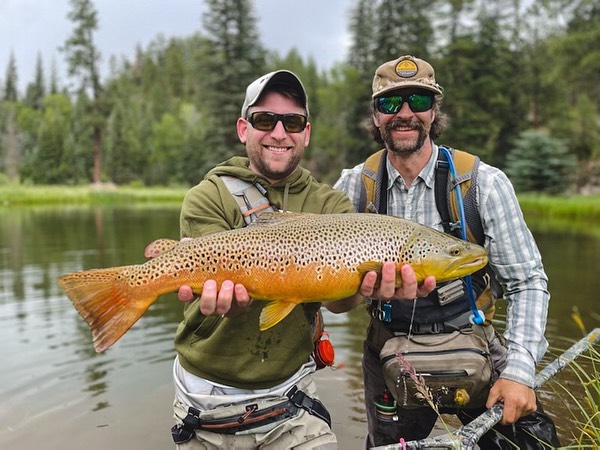
Strip damsel nymphs in weedy ponds and lakes.
Finger Roll – The finger roll is one of the best ways to fish nymph patterns in a lake with floating and sinking lines, though typically done with a sinking line or sink tip unless the fish are higher in the water column or in shallow water. Essentially, you are rolling the line slowly back to you with your fingers. Rather than explain it, just watch this quick short from @FlyFishDan on YouTube.
Jigging – Pretty much the opposite of stripping your line with your rod tip in the water to keep a good connection on the fly. Impart action with a quick rod lift, and then drop again and “strip” the line in to pick up the slack. We don’t often jig flies, but it works on a slow sinking line with a crayfish type pattern when fished on dropoffs. More of an advanced technique as you have to be ready to set the hook when you are not really ready to set the hook on the drop.
Countdown Method – The countdown method isn’t a retrieve, but to be used with your preferred retrieve. Typically done with a sinking line, make a cast, and then count before you start your retrieve. The first cast, immediately begin your retrieve once it lands. Second count to 2. Third cast 5. Fourth cast 10, and so on up to 60 (or more). Wherever you are getting the best bite is the depth you should be fishing. With every cast, count to that number before you begin your retrieve. My preferred line with this method is an intermediate sink with a 1.25 – 1.75 ips (inches per second) sink rate.
Rigs – Rigs for stripping flies in a lake are not terribly complex. At the most simple, tie one fly to the end of your leader and start fishing. When fishing 2 or 3 flies, you can space them 1-3 feet apart utilizing the triple surgeon’s knot tag shown above, tying dropper tags to the bends of your flies in line, or eye to eye with nymphs. Typically with a sinking line, we keep the leader a little shorter to keep your flies close to the weight, while with a floating line, our starting leader is 7.5 to 9 feet in length and then add additional tippet length as needed for depth/number of flies.
Trolling
Before trolling became everyone’s favorite way to interact with other humans on the internet, trolling actually started as a fishing method. Wow!
Trolling is done from a float tube, boat, or other watercraft and is a pretty effective way to fish a lake. We won’t go into great detail about the nuance of trolling, but essentially your watercraft is what is moving your flies. Best accomplished with a sinking line and nymphs or streamers, cast out and behind you (or just drop your line in the water) and start cruising your favorite shoreline or dropoff.
Boat with Trolling Motor – If you have this kind of setup, pick a line and start trolling. Sit back and crack a cold one, you don’t need me to tell you how to do this. Keep your line out of the prop.
Float Tube – Trolling from a float tube with kick fins is a setup where you really don’t even have to cast, just strip off a bunch of line, shake it out the rod tip into the water (or cast it for overachievers), let it sink to the desired depth, and start kicking. While kicking your fins slowly to move yourself and your flies through the water, use short strips or rod tip movements to give the your flies some action. Vary your speed and direction to mimic the movement of natural prey. Keep an eye on your line for any sudden movements or twitches, or when you feel a fish strike, set the hook.
Repeat all day and try not to fall asleep. The rocking of gentle waves can do that. Trolling can also be done from a kayak, canoe, SUP, or any other self-propelled craft.
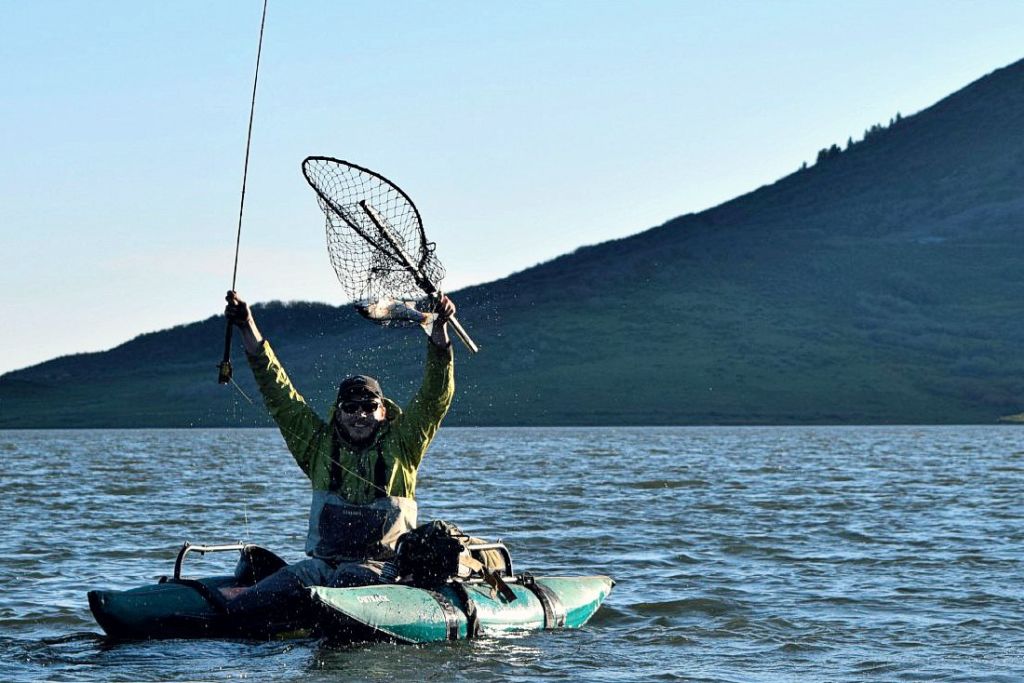
Wind Drifting and Loch Style
Not a lot of fly anglers love the wind. Everyone wants that glass calm day to spot fish and make beautiful casts. That is not how it usually goes. Sometimes, fish like the wind which gives them a little surface chop to hide from us. Rather than fight the wind, make it your friend. Use the wind direction to direct the drift of your boat to effectively cover water. For example, if the wind is blowing north to south, pick a northern spot on a shoreline or lake, and let it blow you to the southern end.
You can make casts and retrieves, drift a bobber rig, or troll your line through the drift. Pick your poison.
Unlike using a motor, oars, kick fins, or paddle to troll, your movement is directed by the wind…which makes you subject to the forces of nature. Use that motor, paddle, or kick fins to say on track and not run aground. You can also use a drift sock to slow down the speed of your drift and stay in the zone longer. If you really want to get techy with the drift sock…
Loch Style – This is a method of lake fishing developed on, you guessed it, lochs in the UK. It’s not used a lot in our area but is still a great way to catch trout. Done from a motor boat or drift boat by attaching a ‘drogue’ or wind sock to the front and rear of the boat to help keep your boat perpendicular to the wind and slow the speed of your drift. This method allows you to cover a lot of water with two anglers fishing out of the front and back with dries, nymphs, streamers, floating lines, and sinking lines. A quick Google search of Loch style fishing will give you more than enough info to get started. A great (and underutilized) method of fly fishing our area.
Dry Fly Fishing
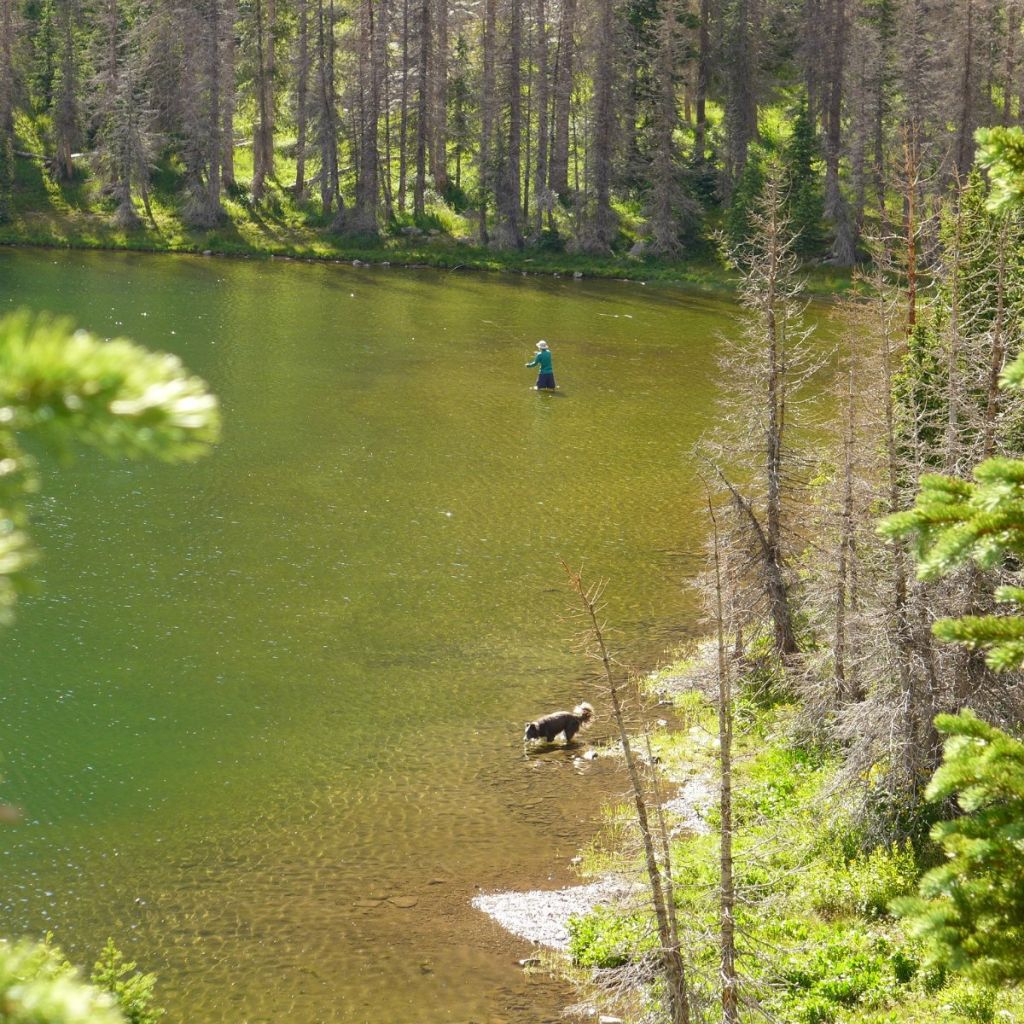
Finally, dry fly fishing; everyone’s favorite way of catching trout. There are two big differences between fishing a dry fly on a river from on a lake.
- You don’t have to worry too much about getting a drag-free drift! Yay! If you have a heavy wind or current, you may end up getting a little drag, but for the most part, your fly and line will be chillin’.
- With no current, your fly isn’t moving to the fish, the fish are moving to the fly…which can make it more difficult if they are being picky…
So the key is either spotting a cruising fish and casting your dry fly to where they will be (leading them), or casting to an area where fish seem to be rising and hoping one spots your fly. Casting to where a fish just rose seems to yield less trout than you would think. If you can spot a rising pattern of a fish coming down a bank, try to anticipate that fish’s line and make a proper cast so that they will intercept your fly.
Dry fly fishing is very common on high country lakes in the summer, but it can also be difficult with gin-clear, glass-calm waters. Trout seem to be spooked by any movement. This requires patience and fortitude. You may need longer, lighter leaders and lead cruising trout much further so that your fly and line have time to settle before the inspector arrives to approve or deny your offering. Zipping fly line, splashdown, and ripples can all spook trout.
A favorite method for us in the summer is a dry/dropper rig with a terrestrial/ant pattern and a 2-3 dropper to a Zebra midge or chironomid. Summer vibes all around.
Conclusion
We hope this beginner’s guide helped you learn a thing or two about fly fishing lakes for trout. Some days it seems like it’s easier than dunking worms, other days you wish you had some dynamite. Either way, our local lakes here in Colorado offer some fantastic fly fishing opportunities that should not be missed, especially in late spring and early summer when rivers are blown out and it feels like “there is nowhere to fish”.
Swing by the shop, we would be glad to help you get set up to catch a few trout on our favorite lakes. In the meantime, get pumped on this quick little video we made a few years about fishing a favorite high country lake here in Colorado.


